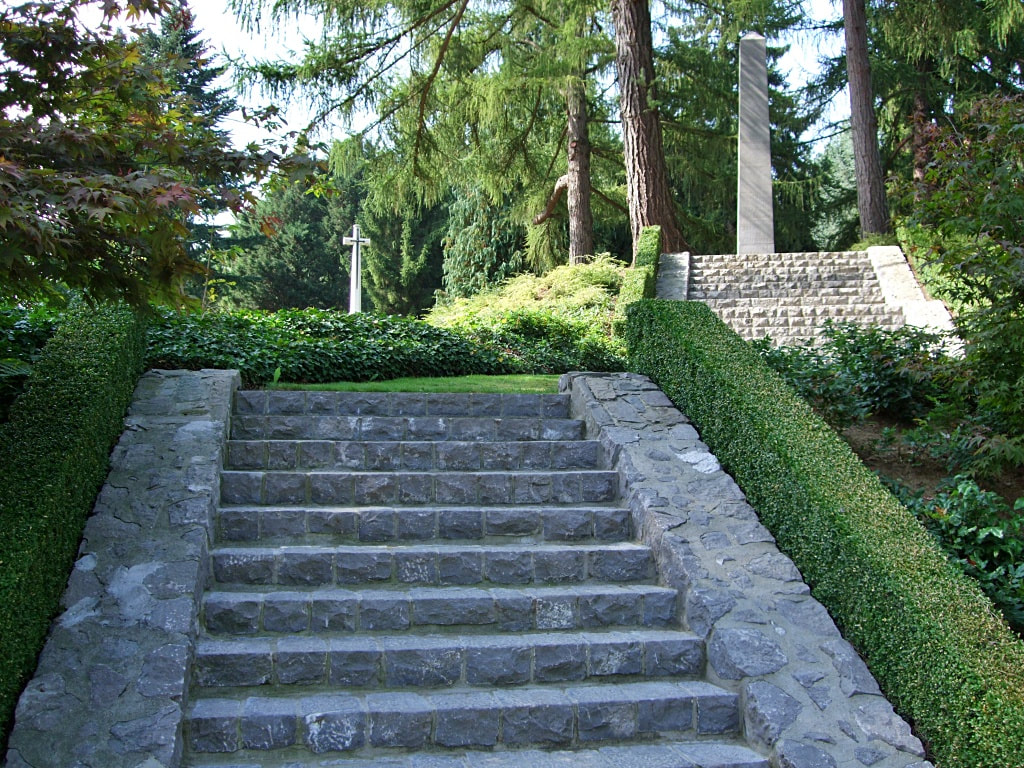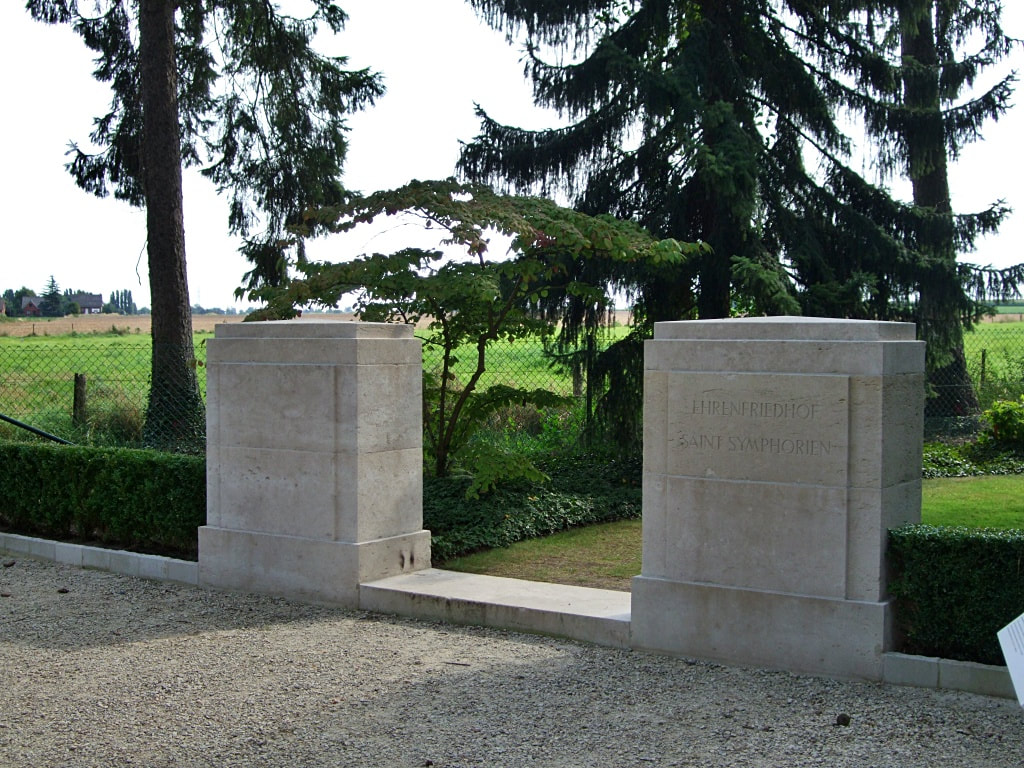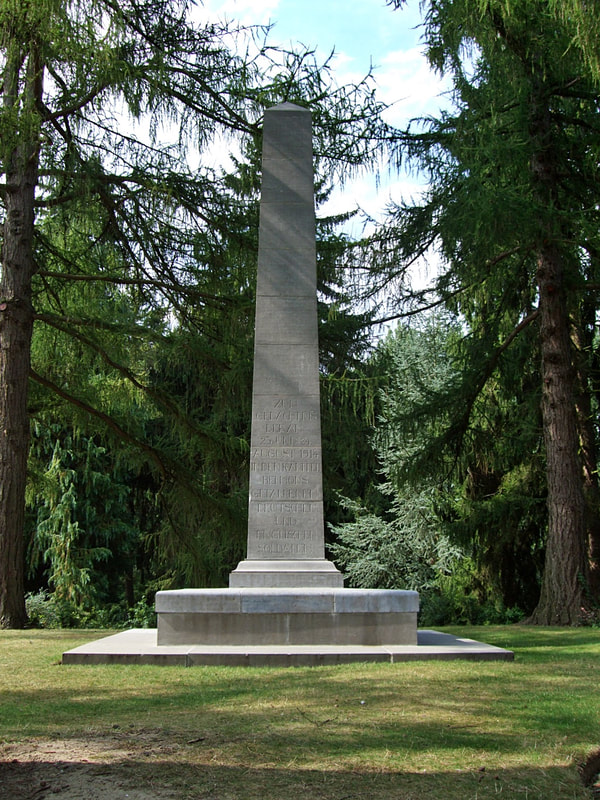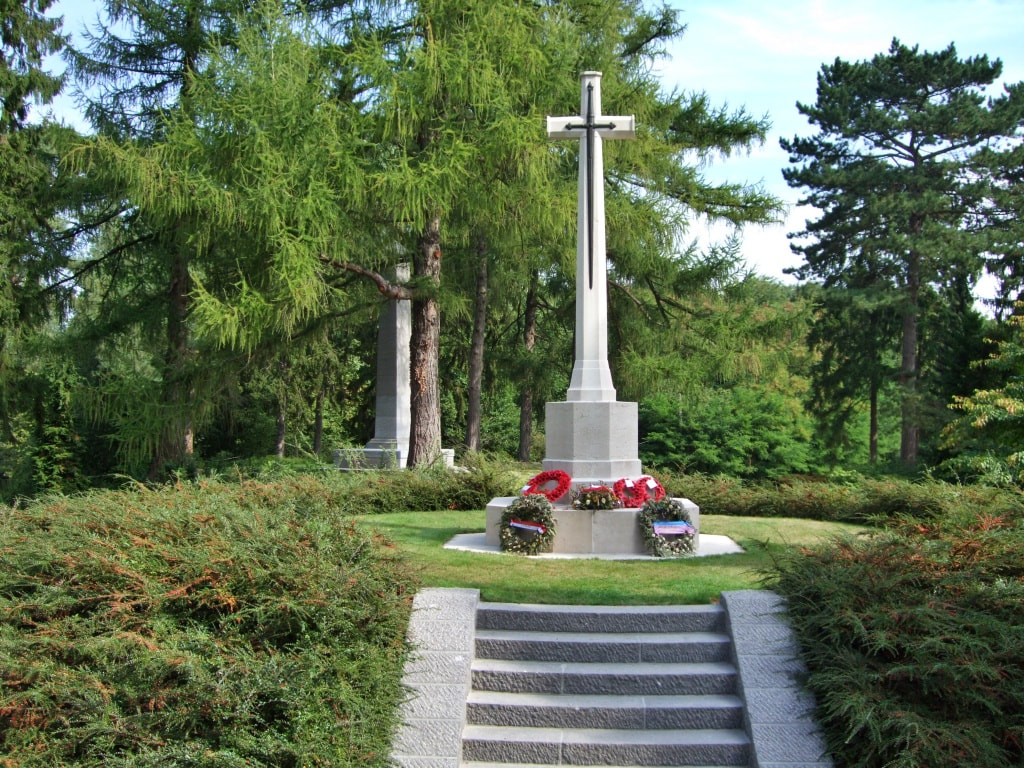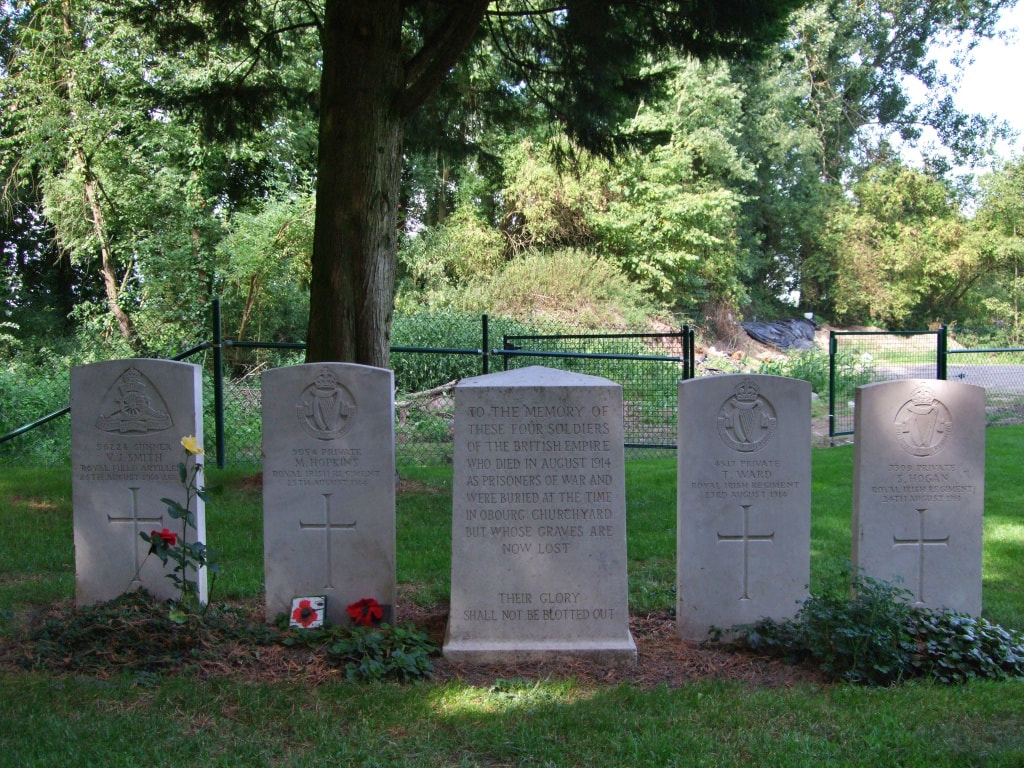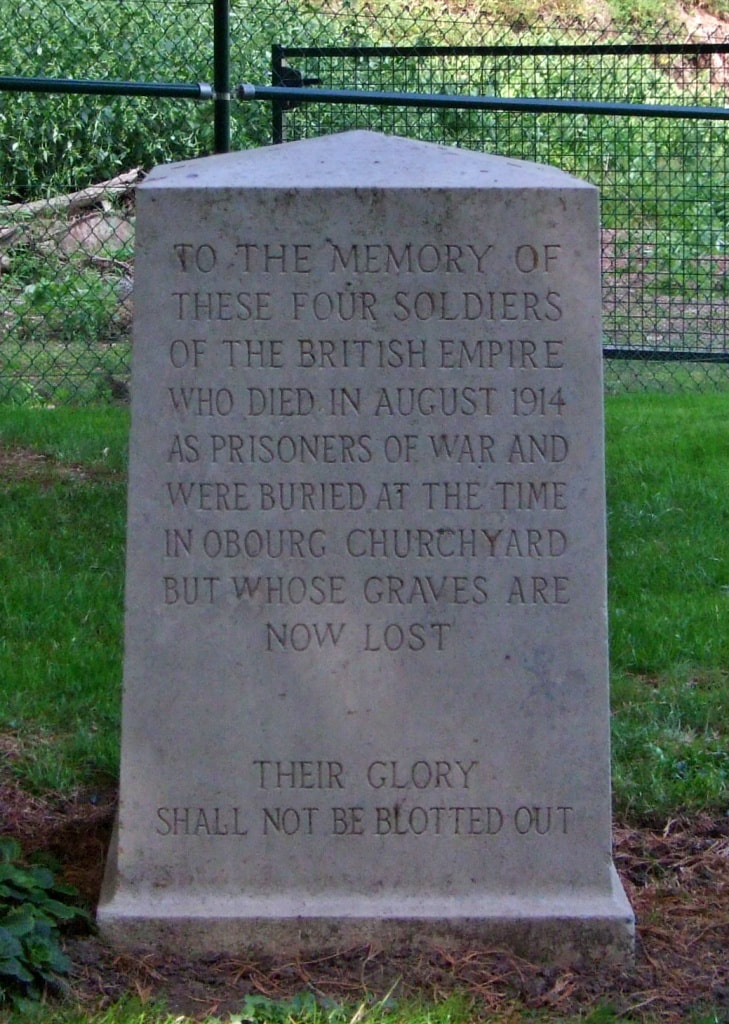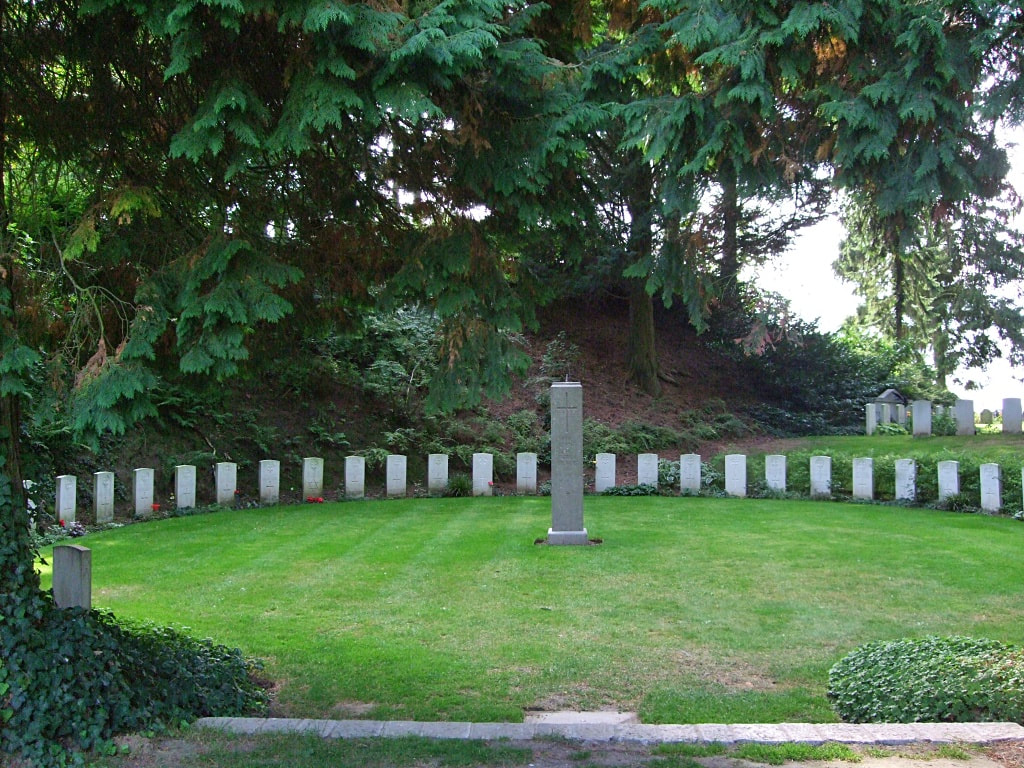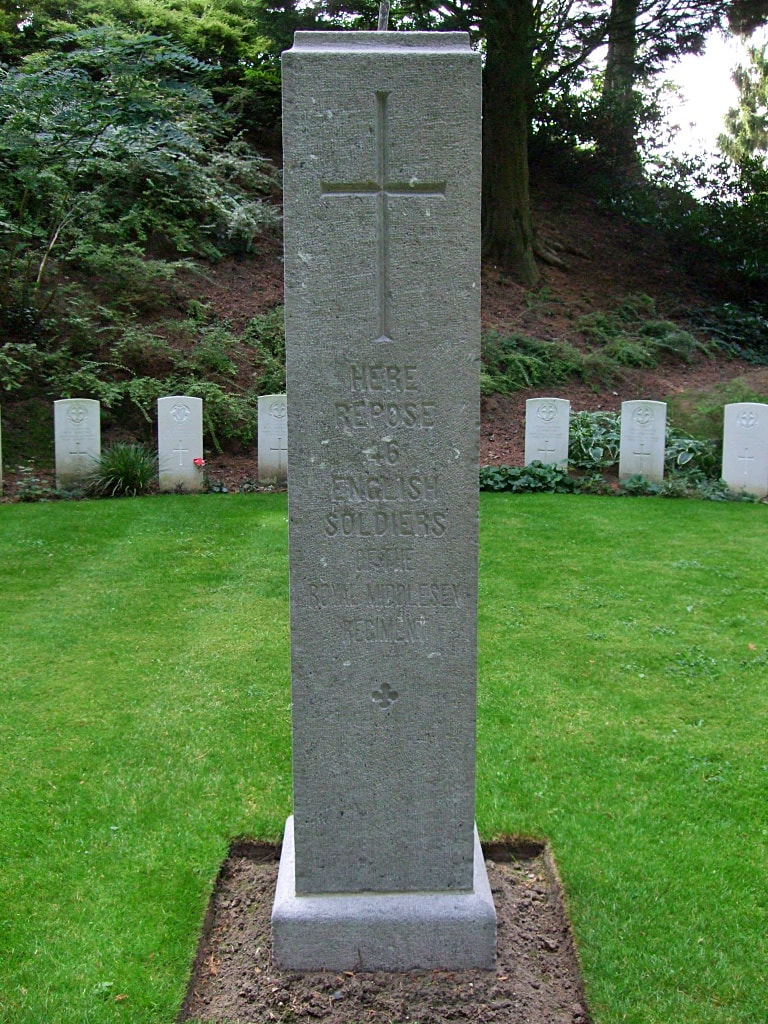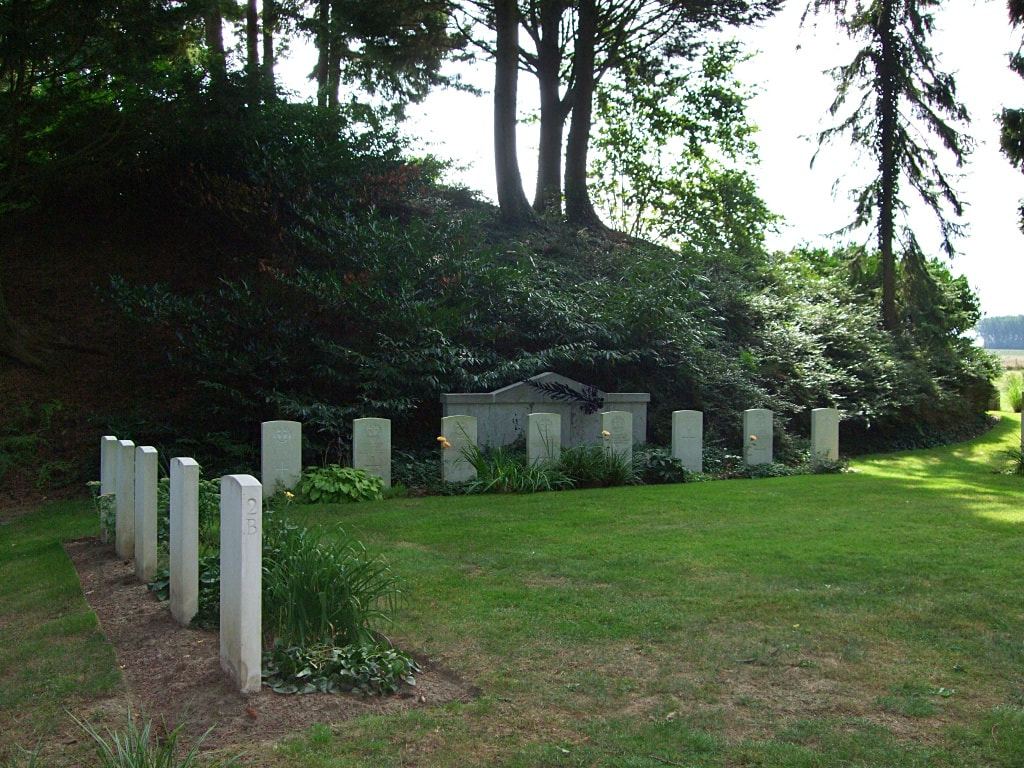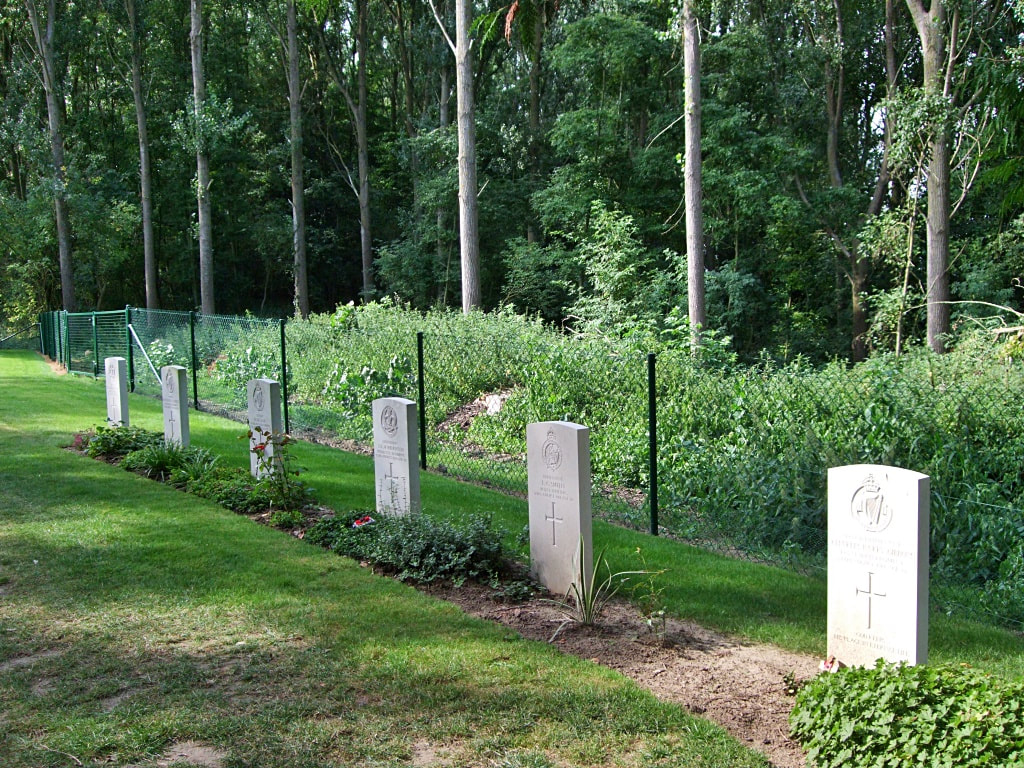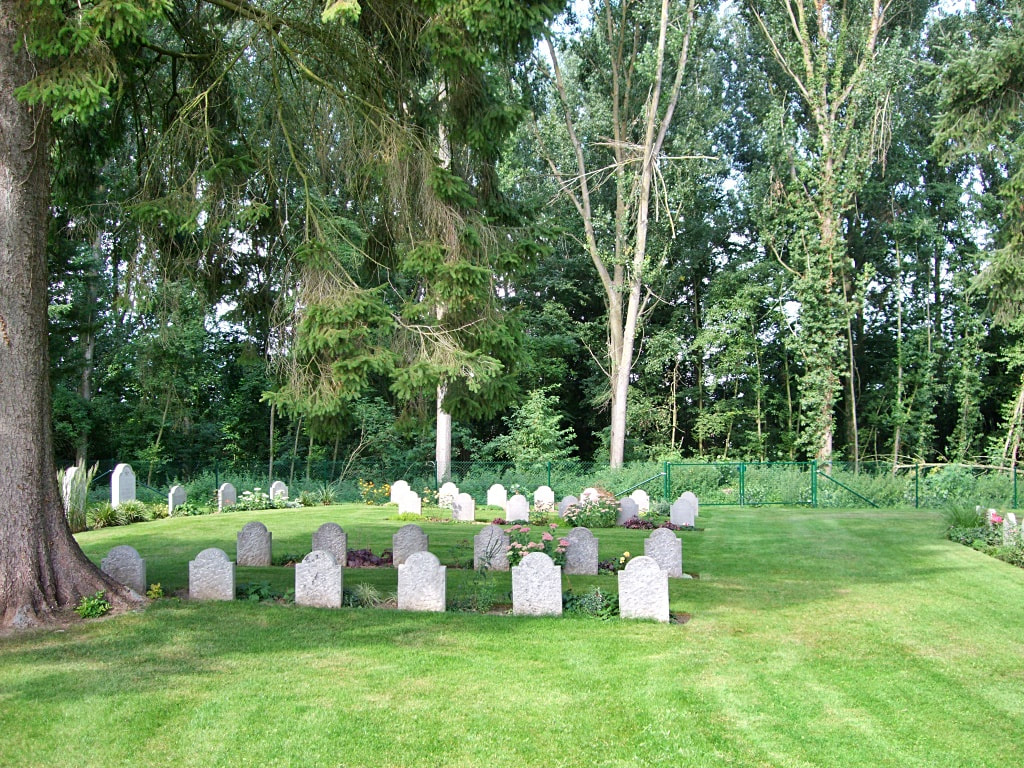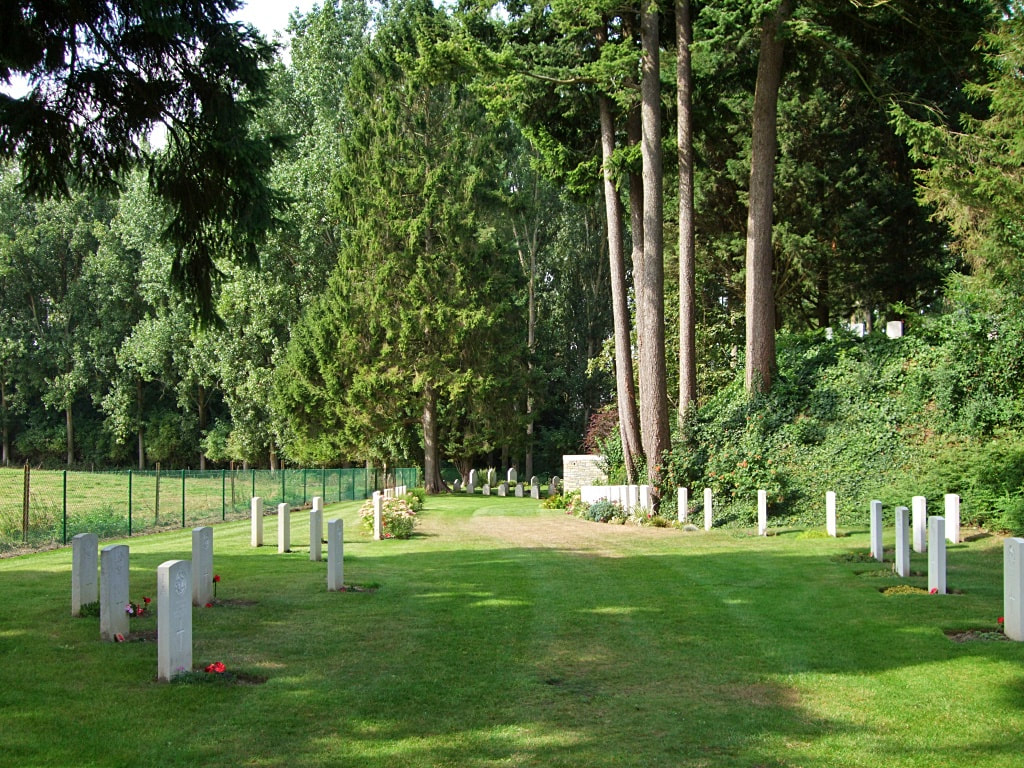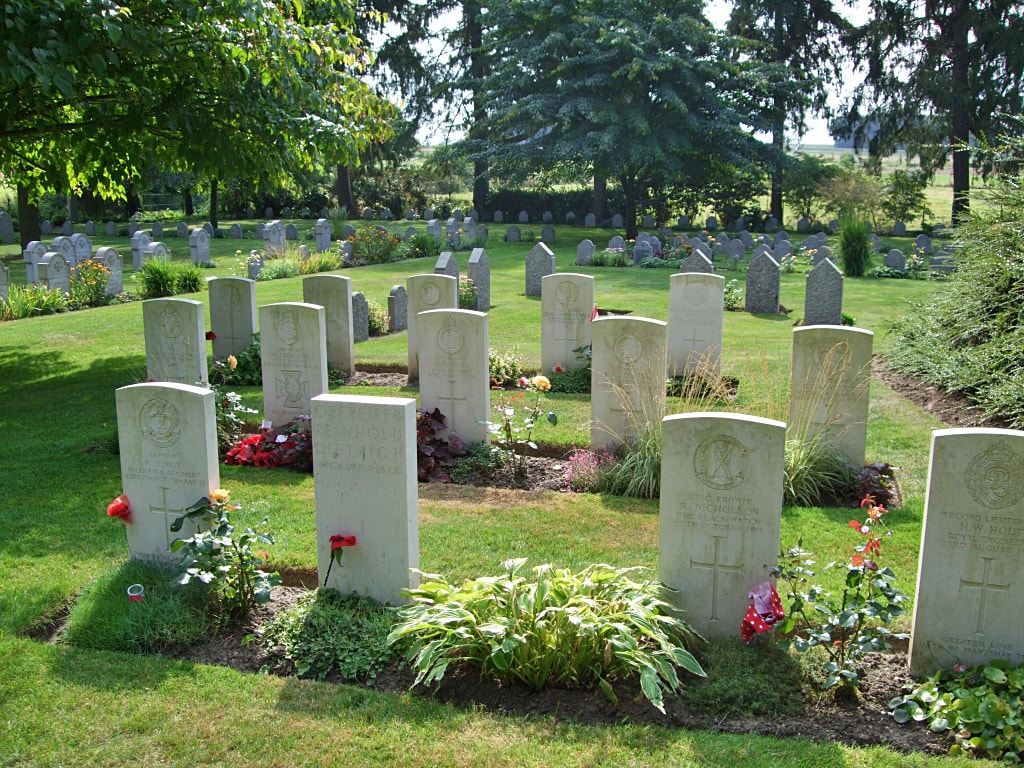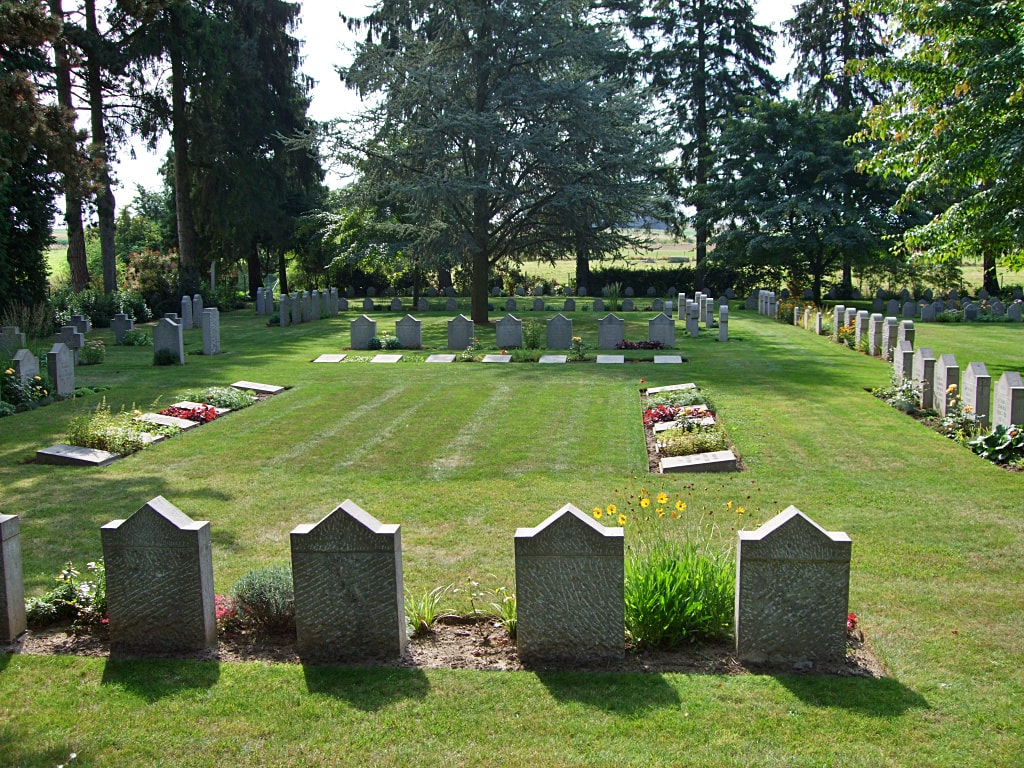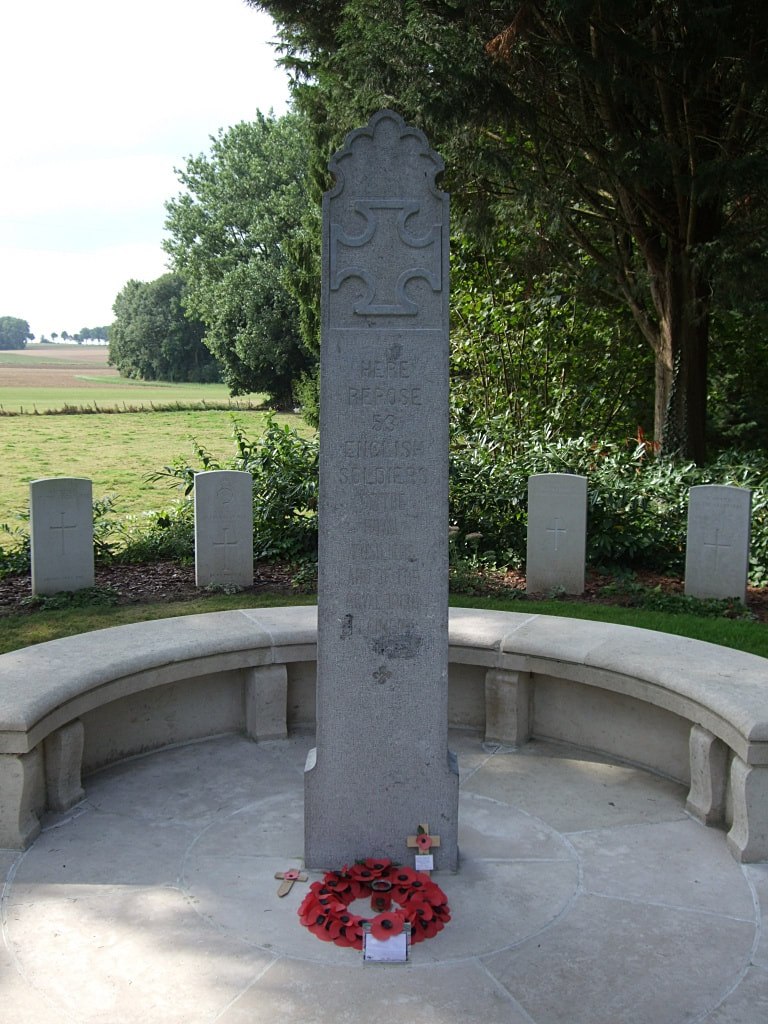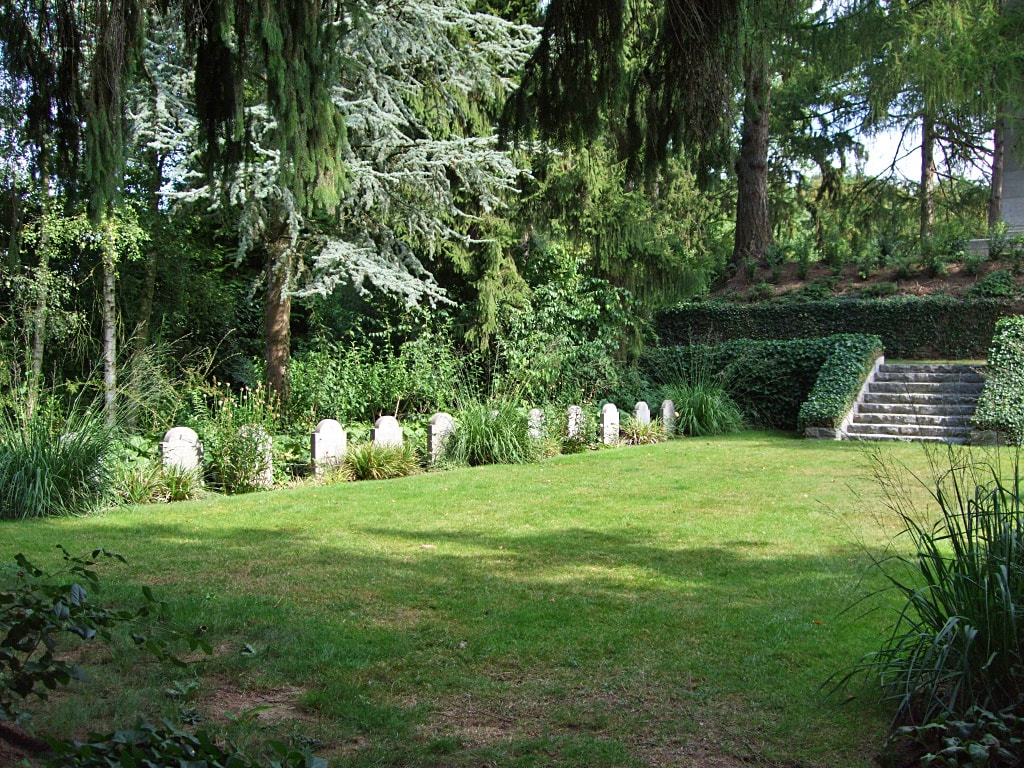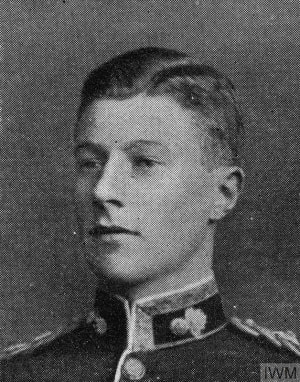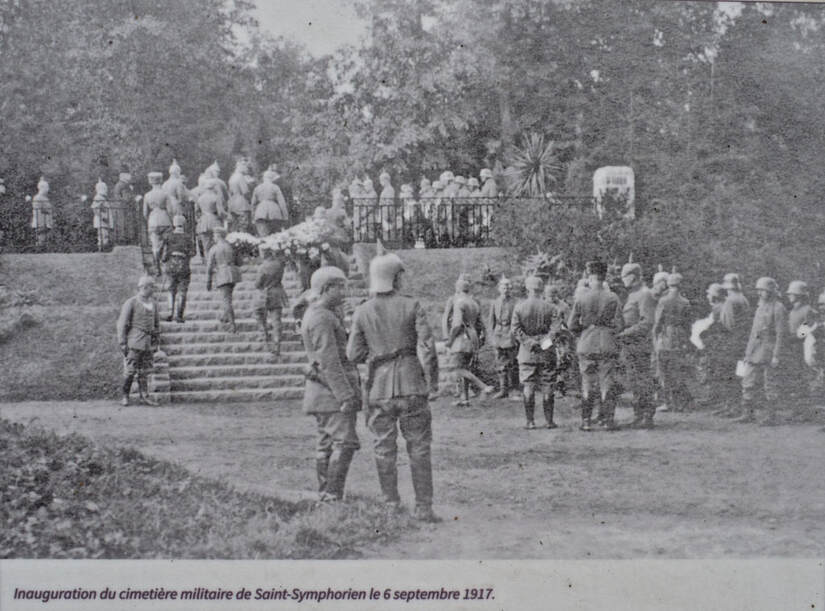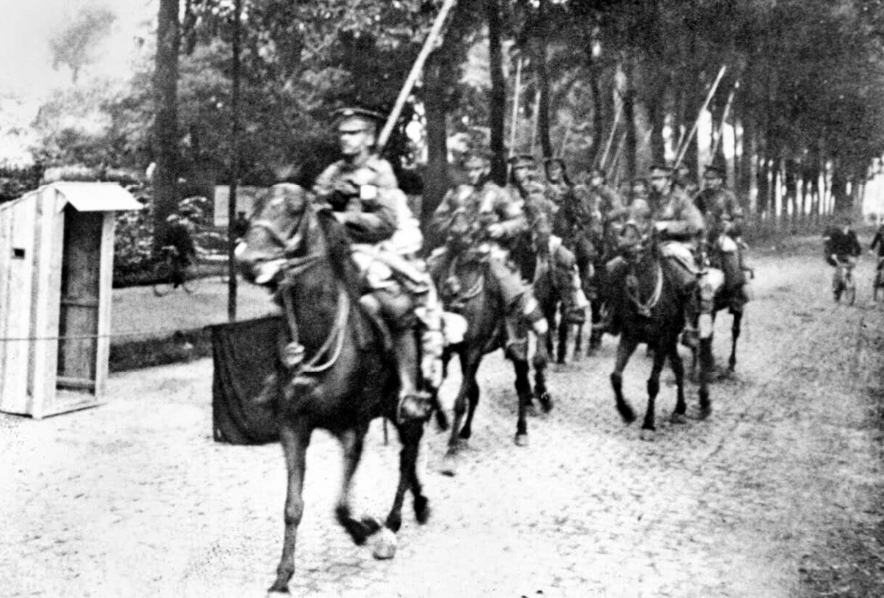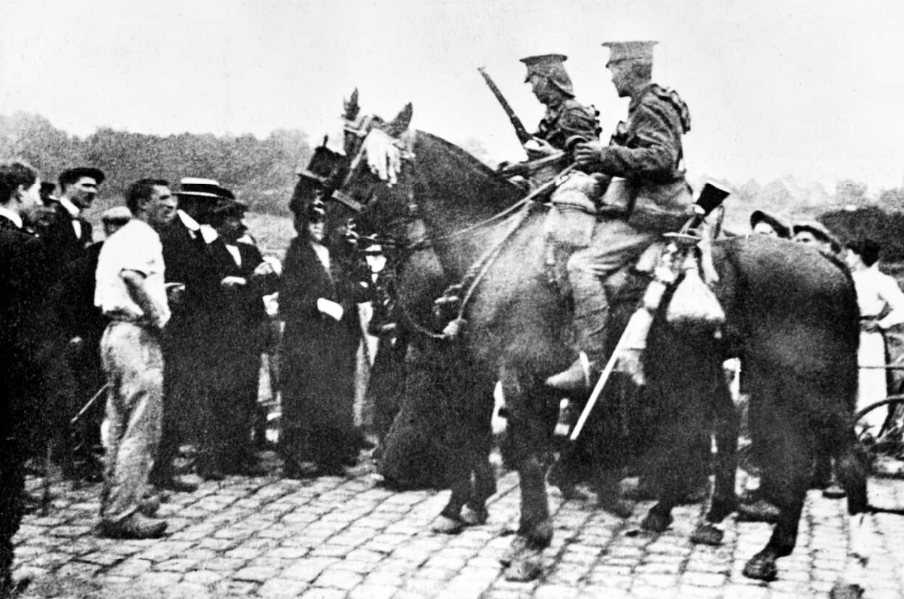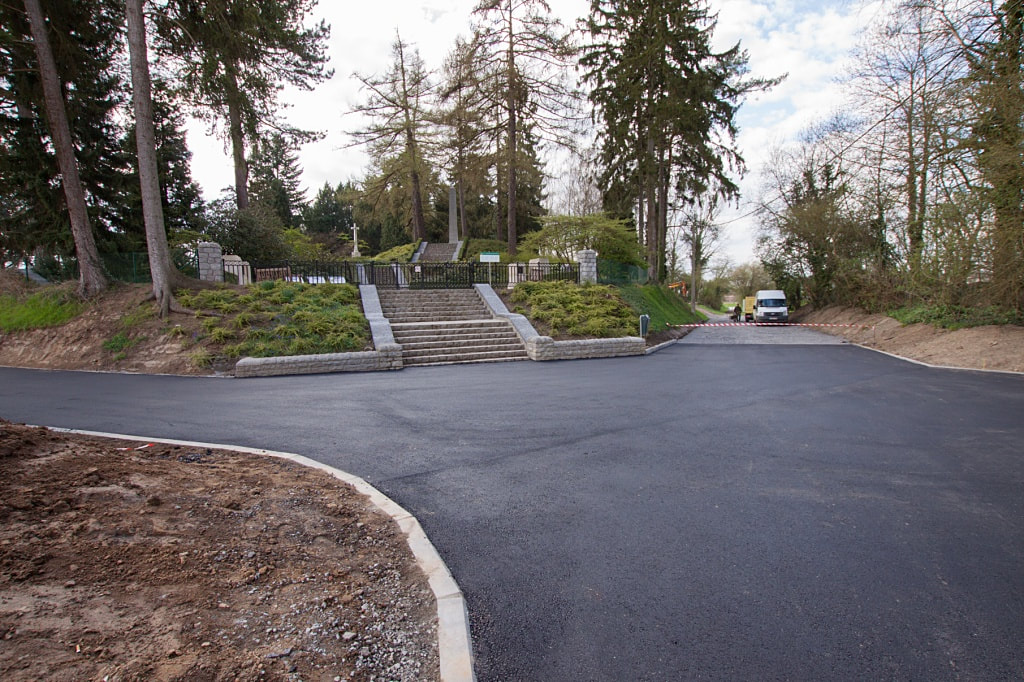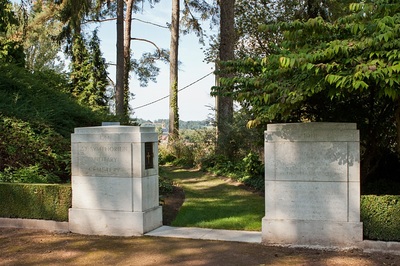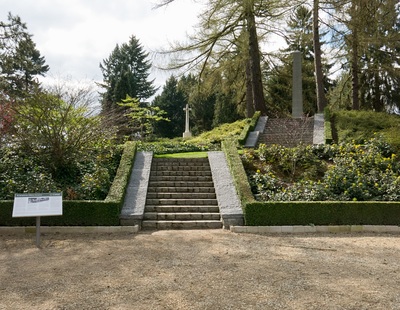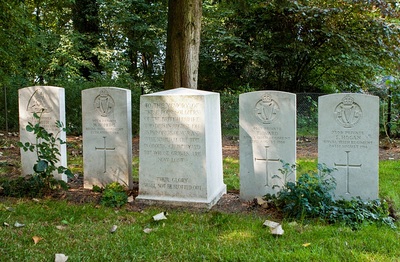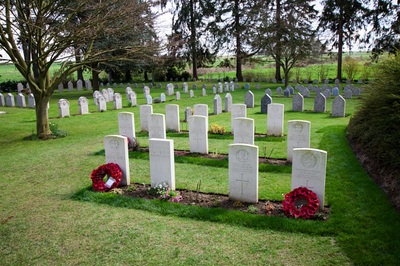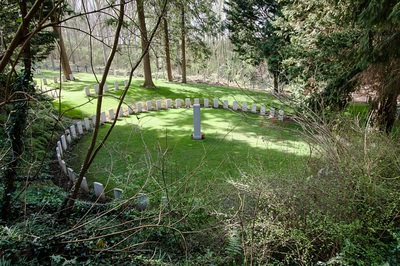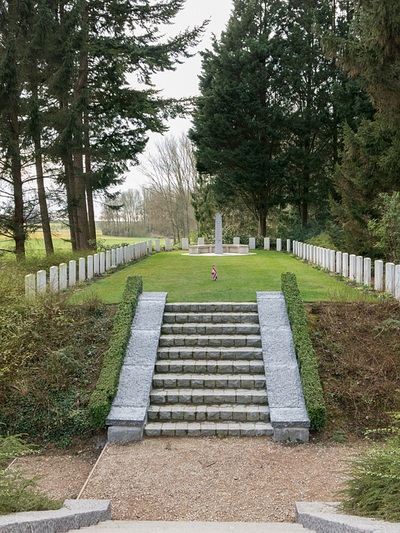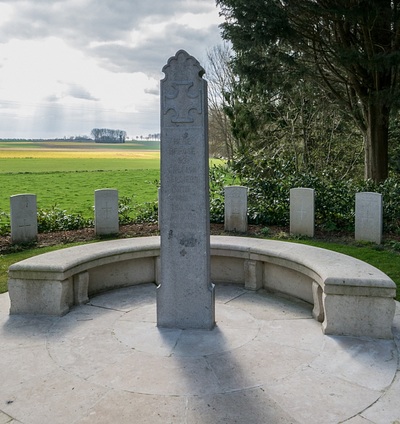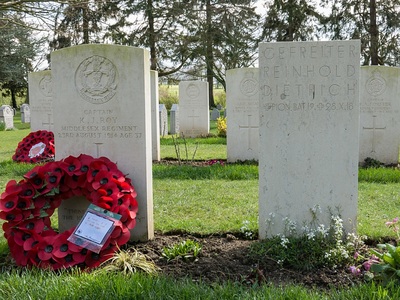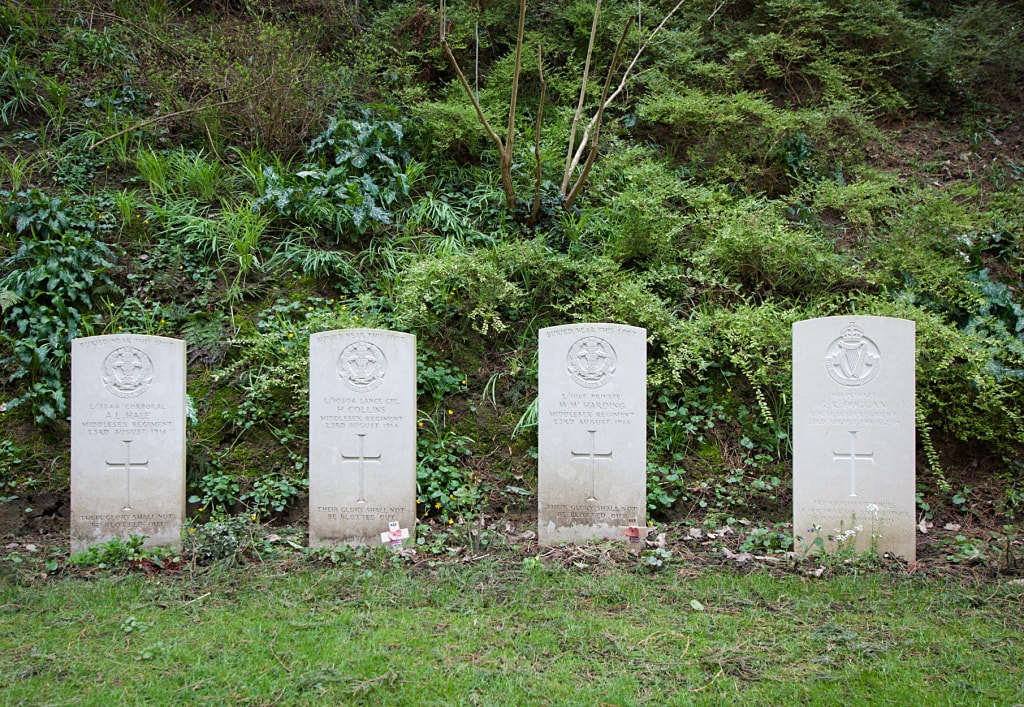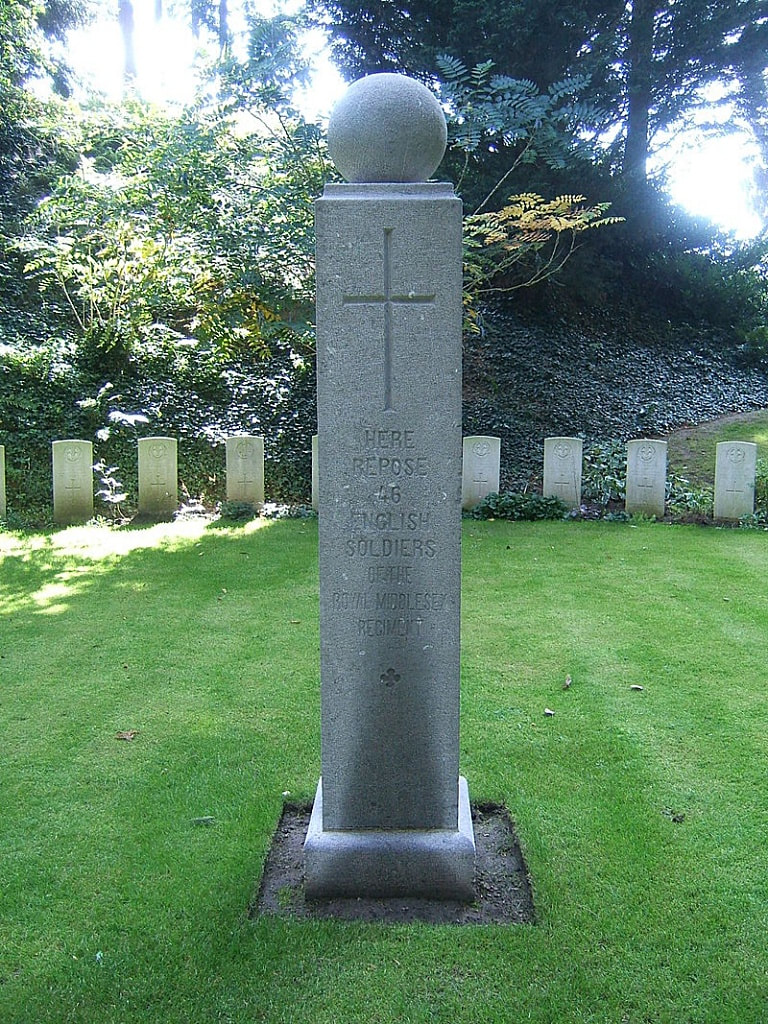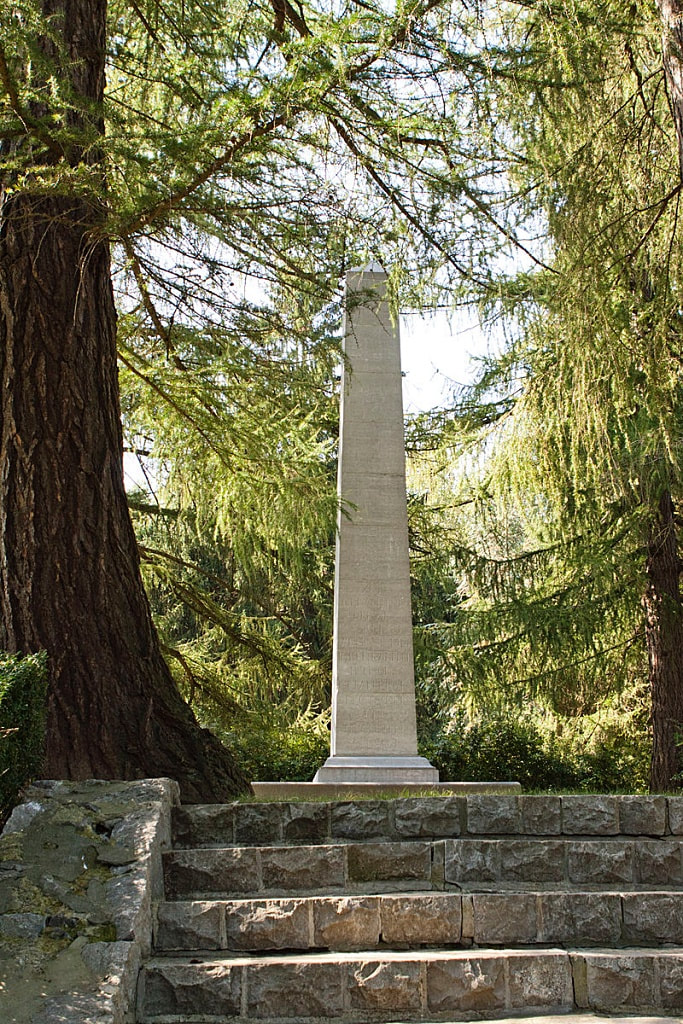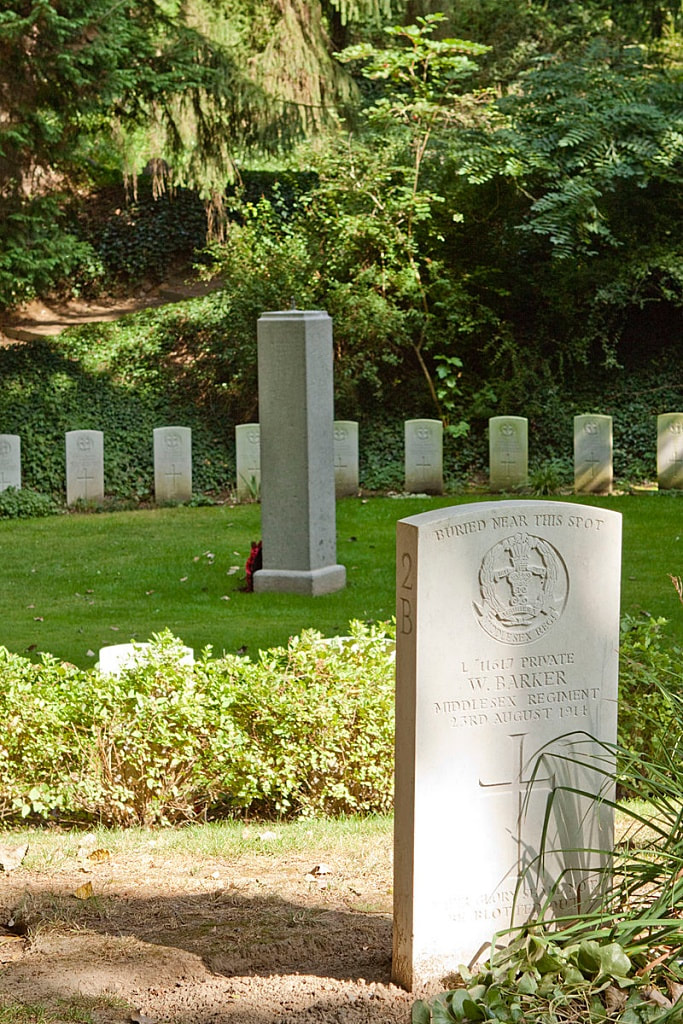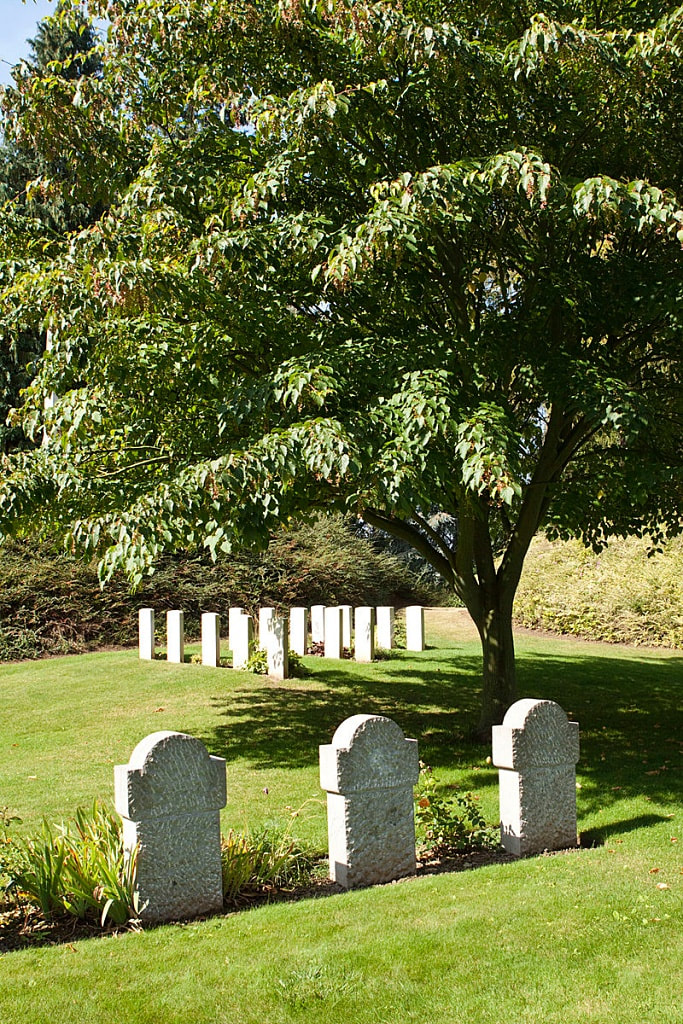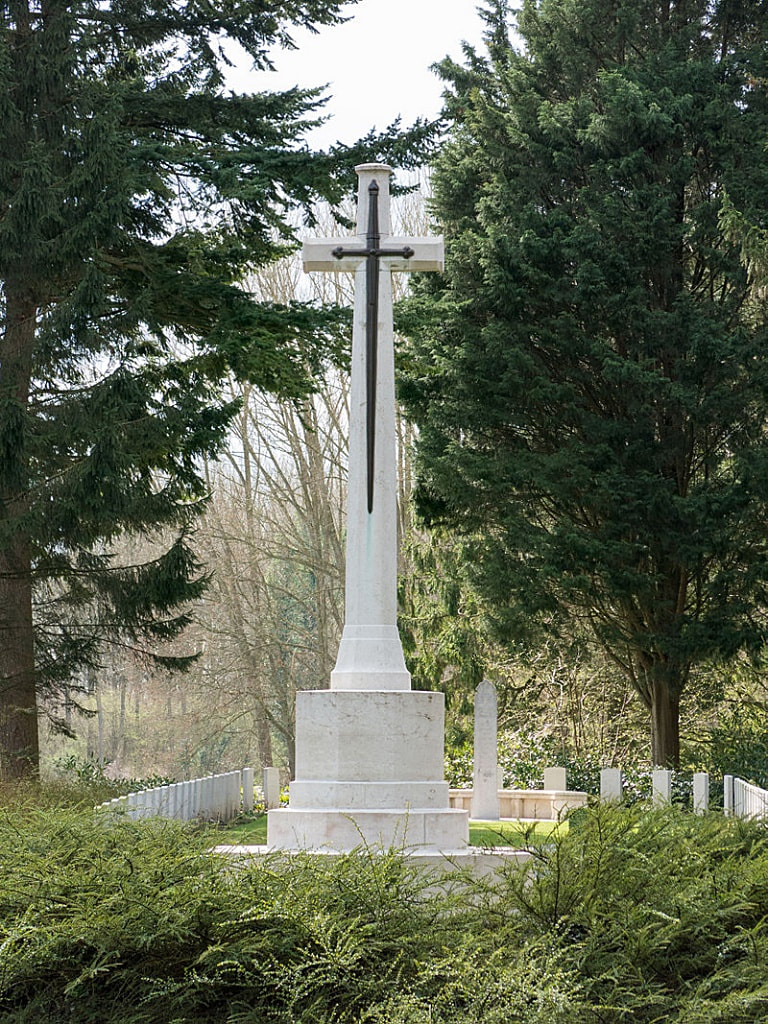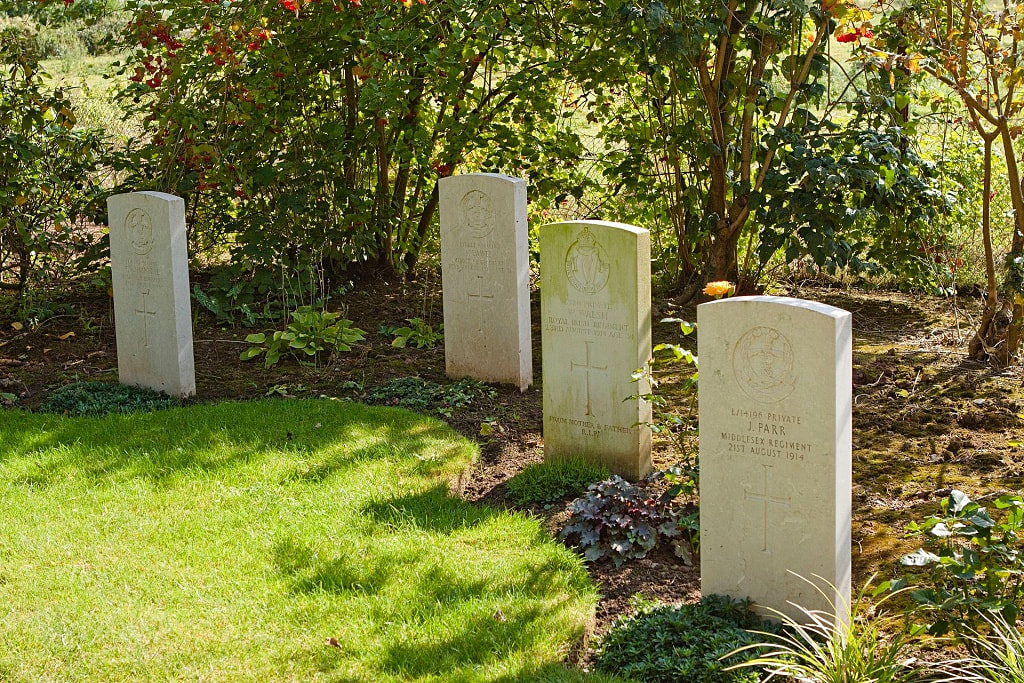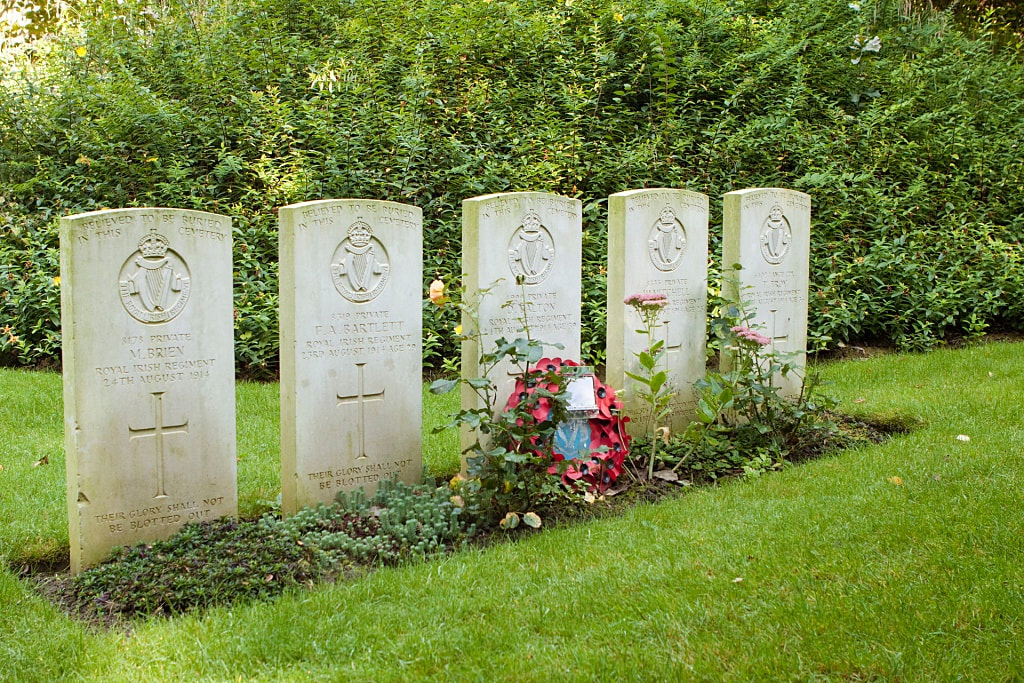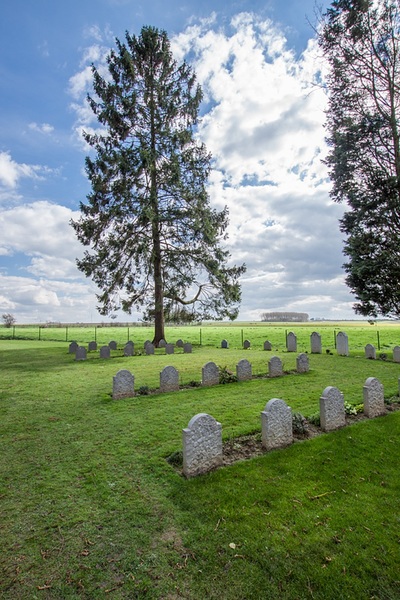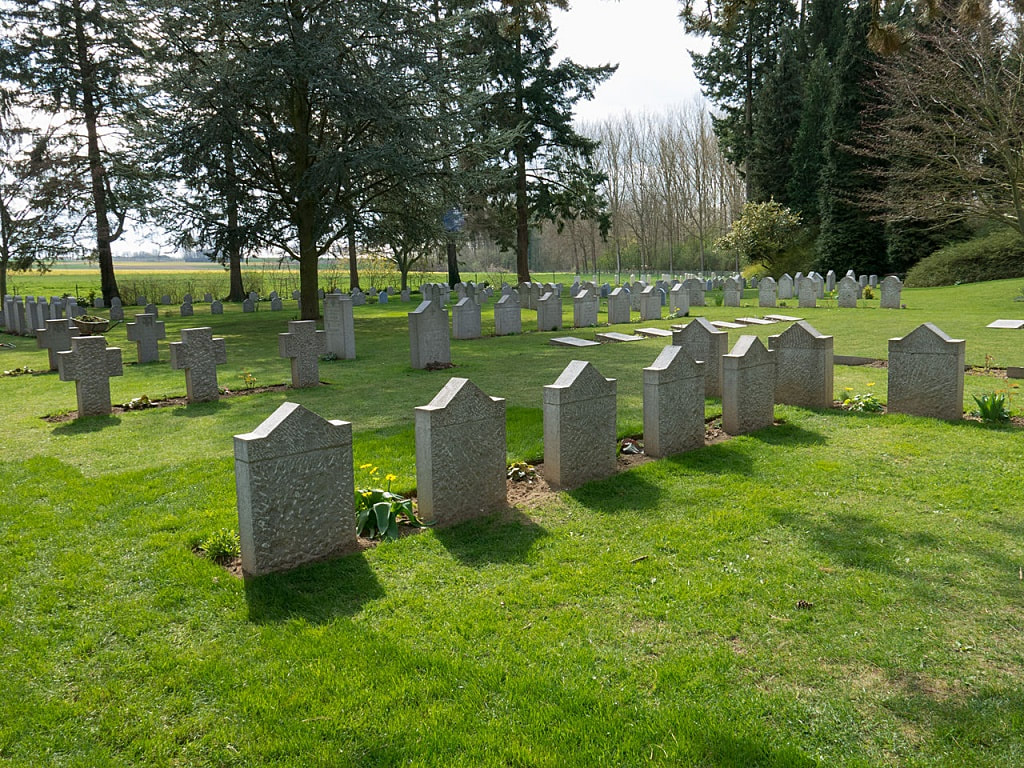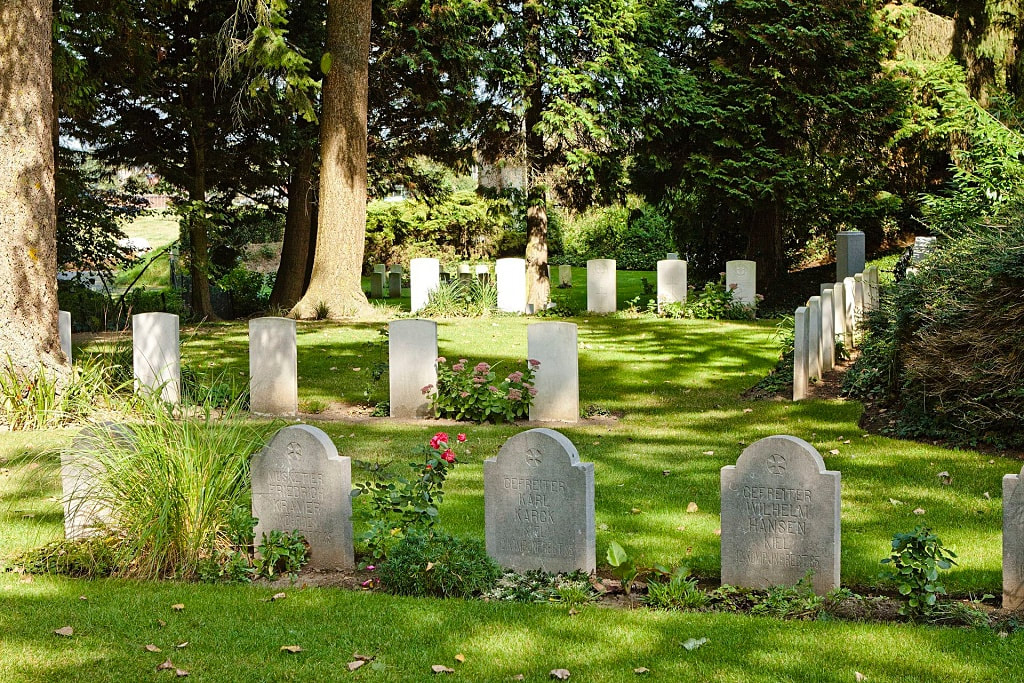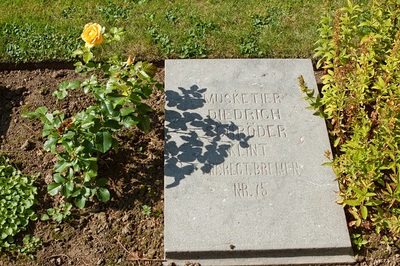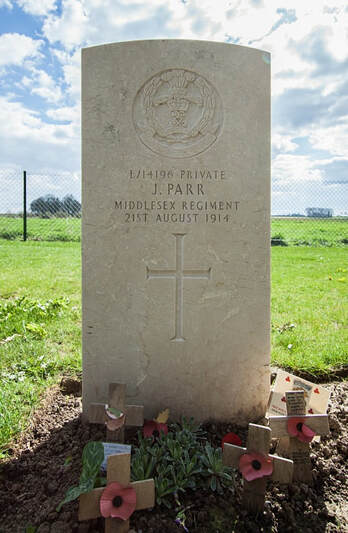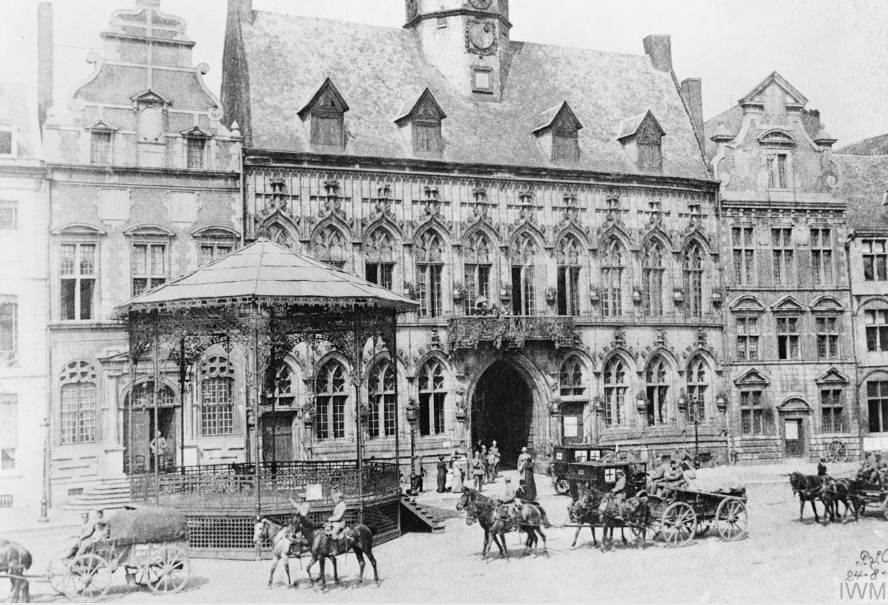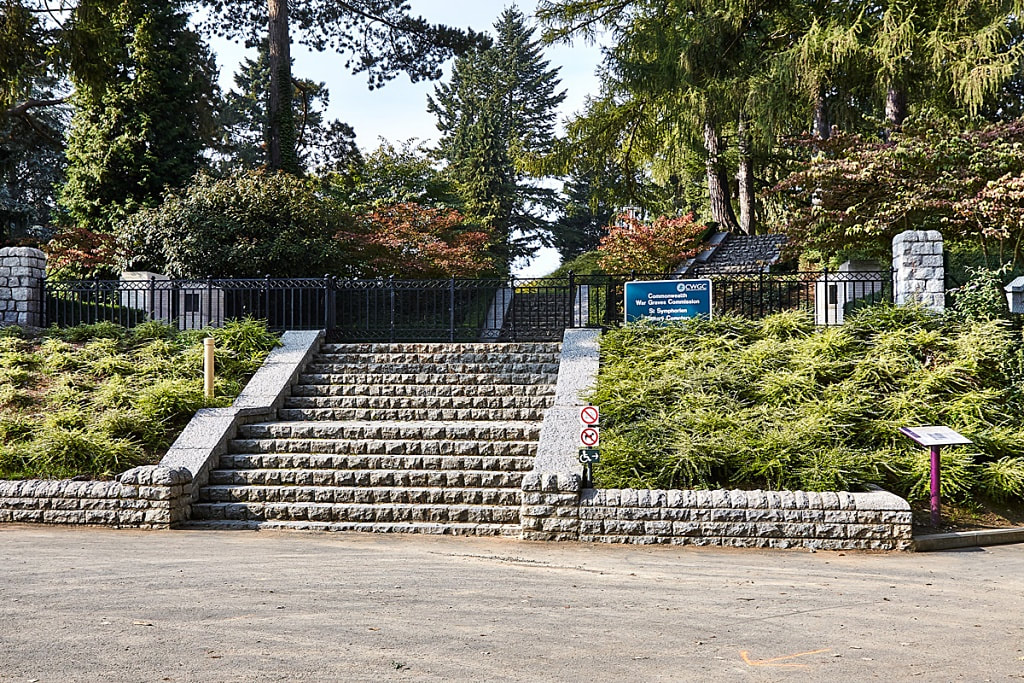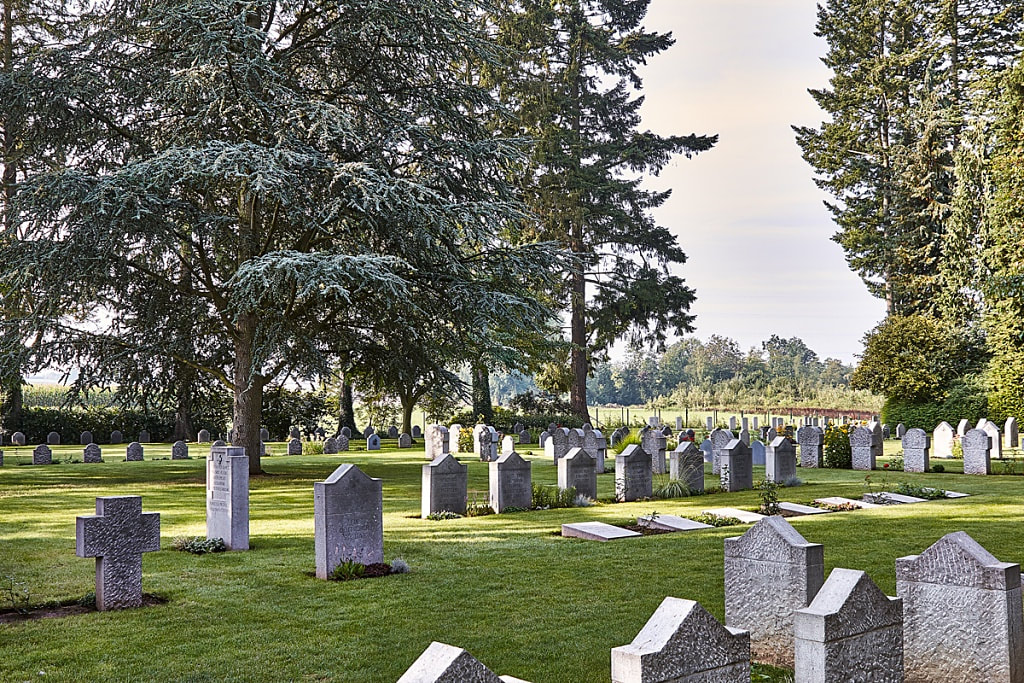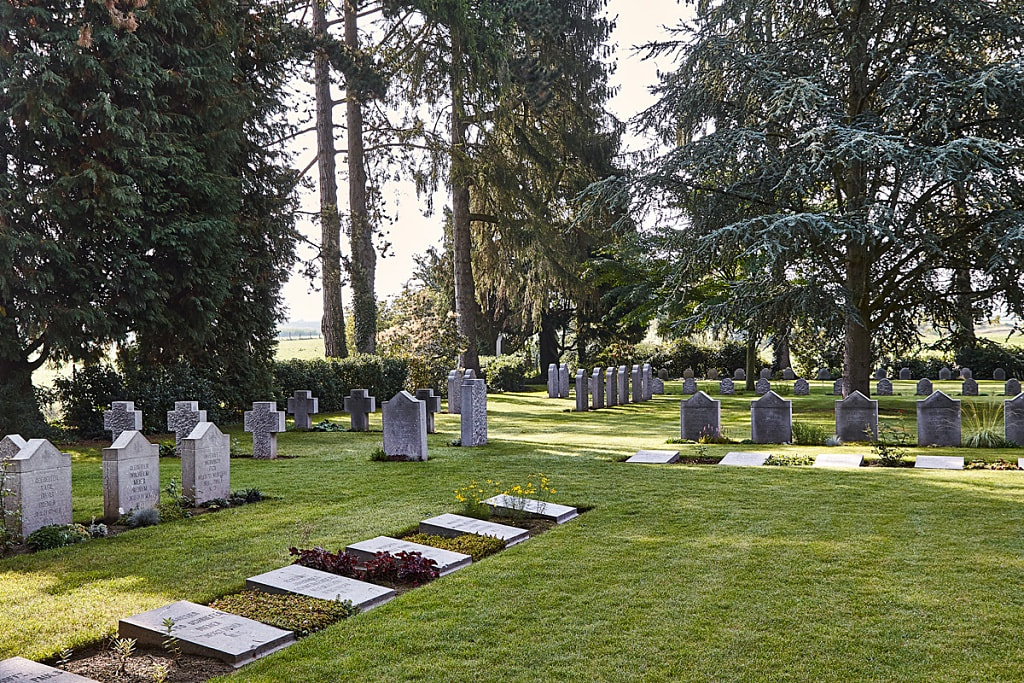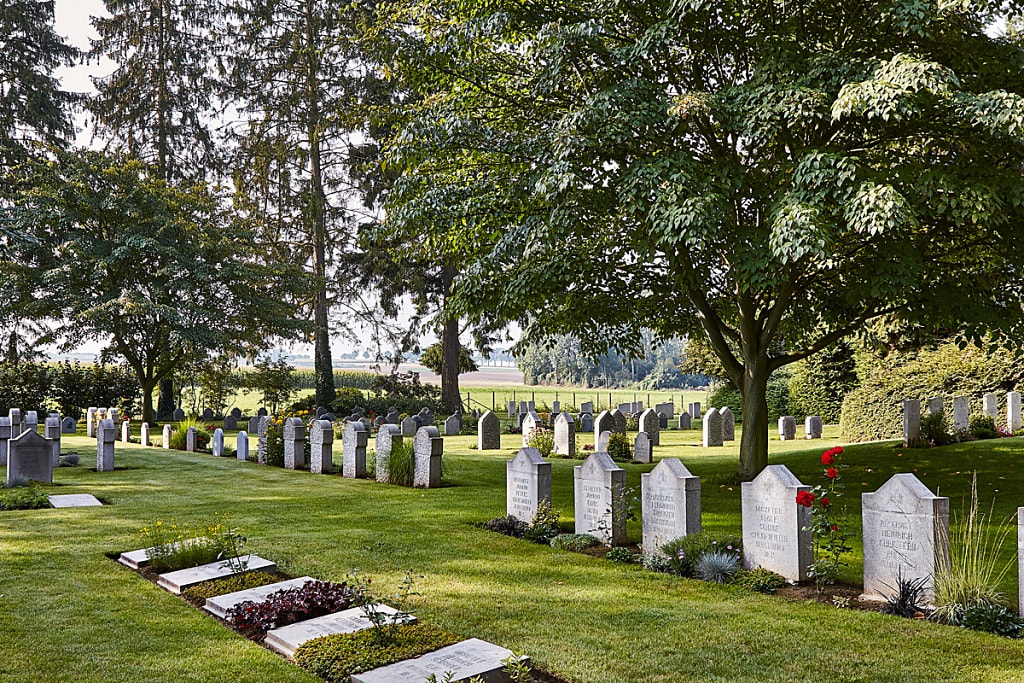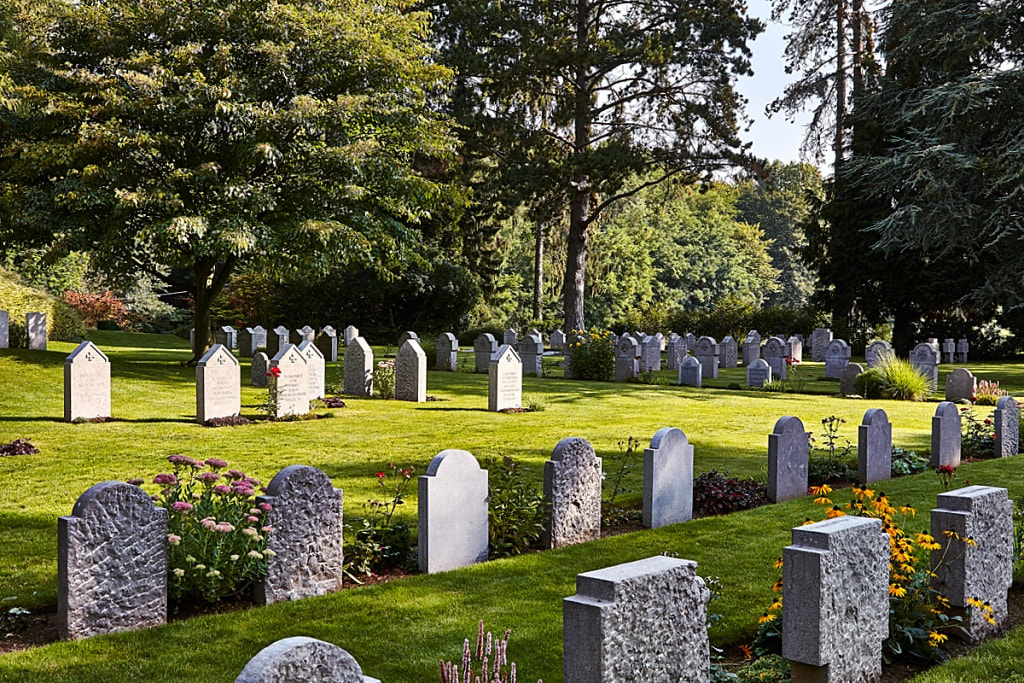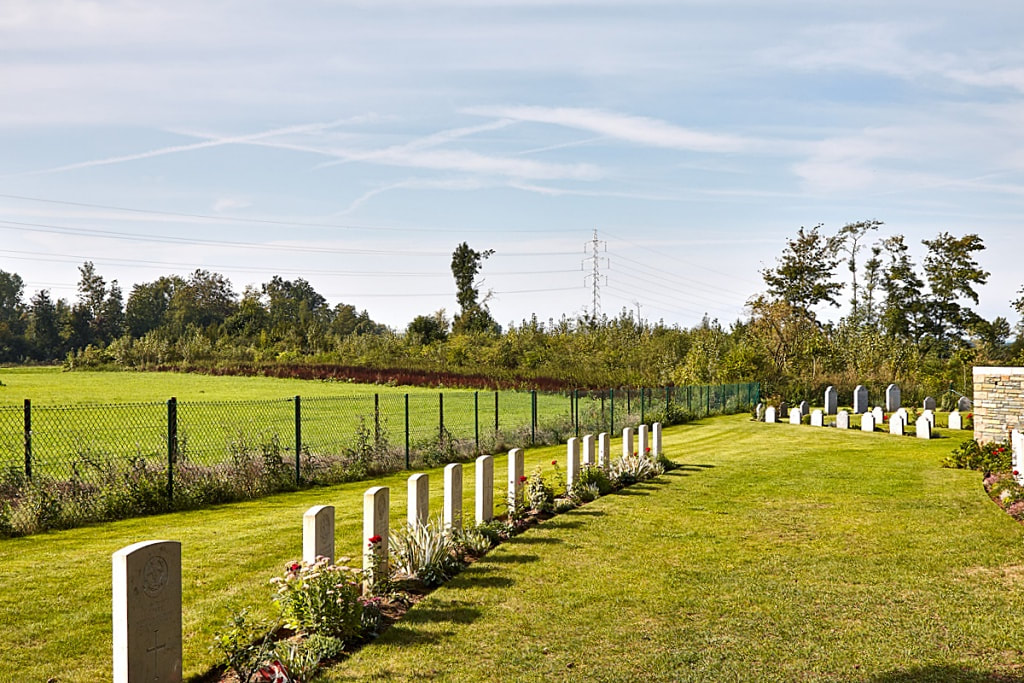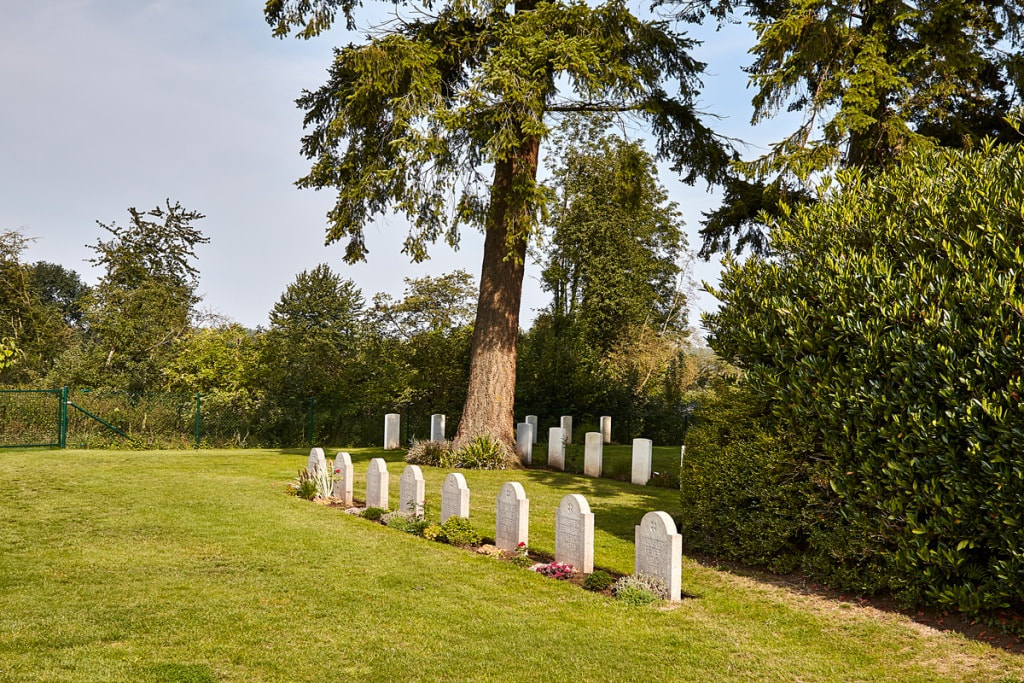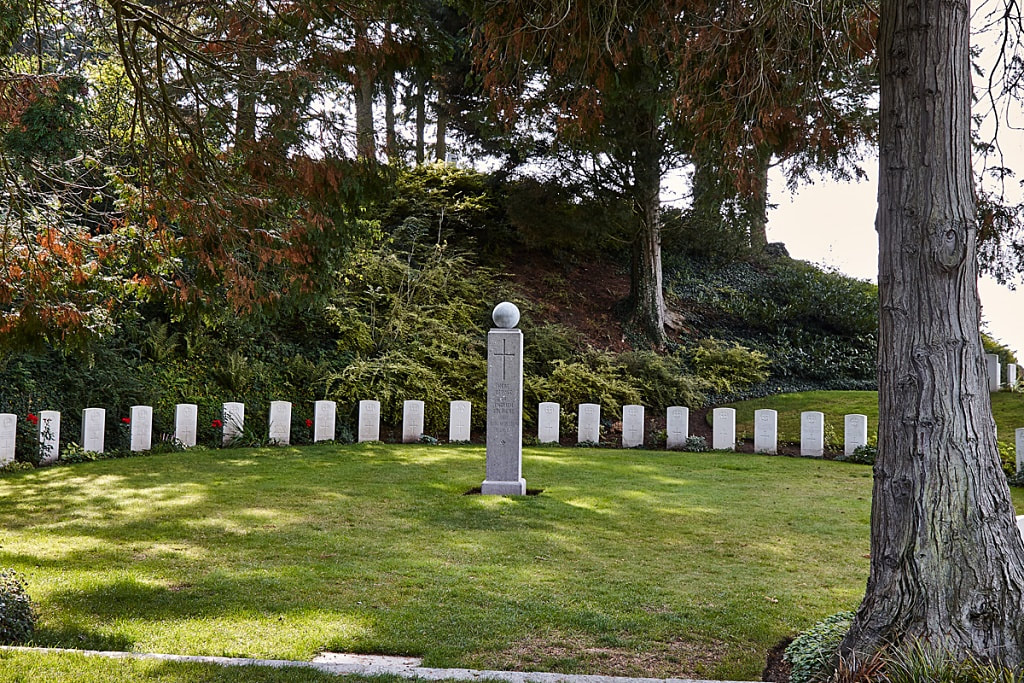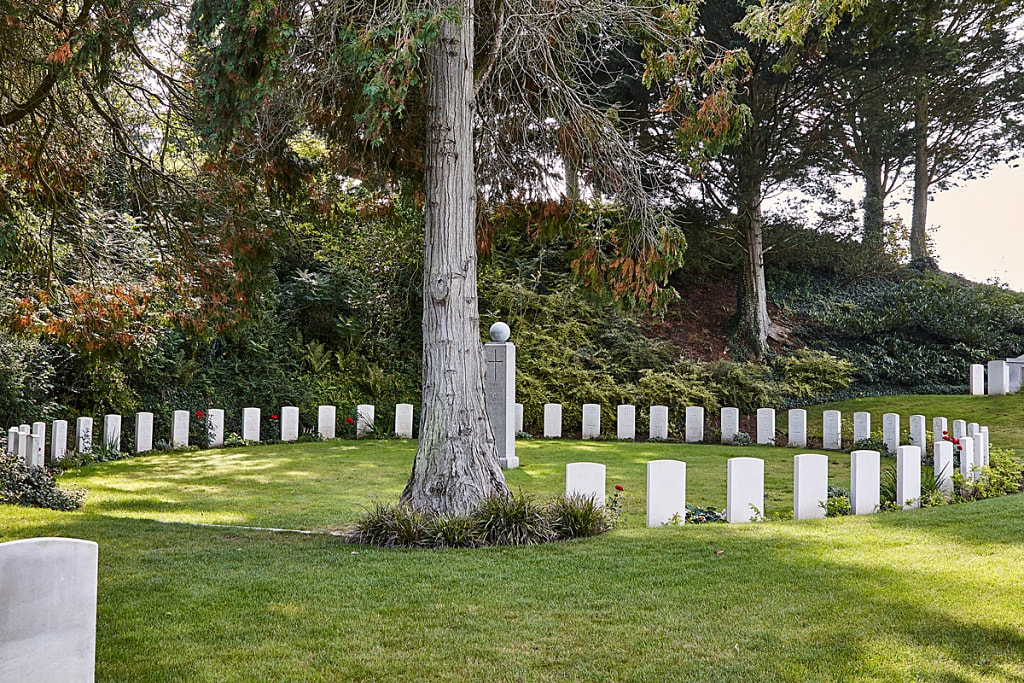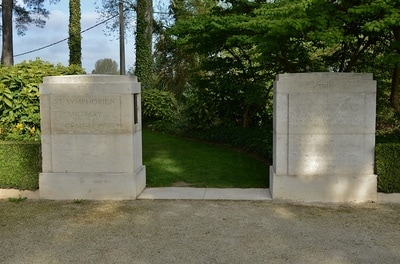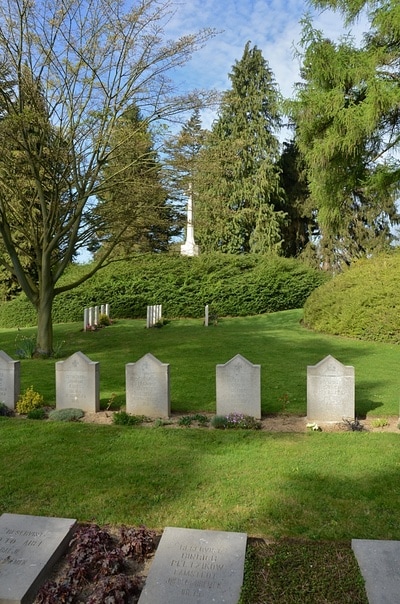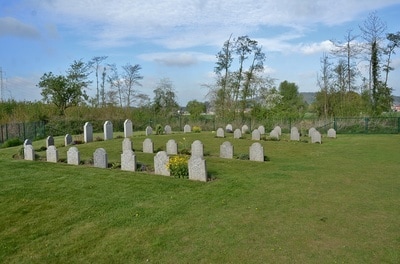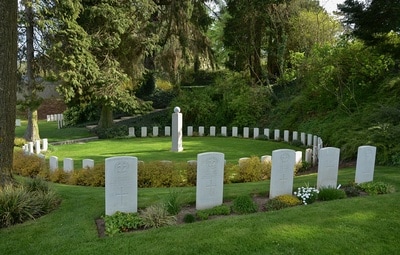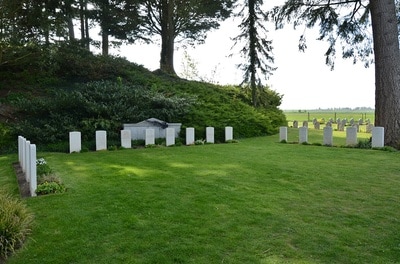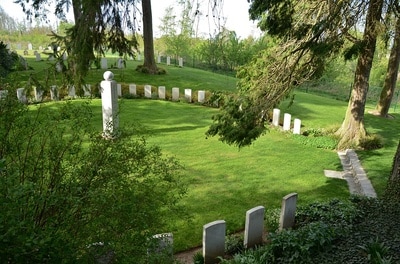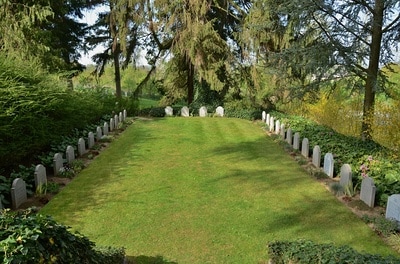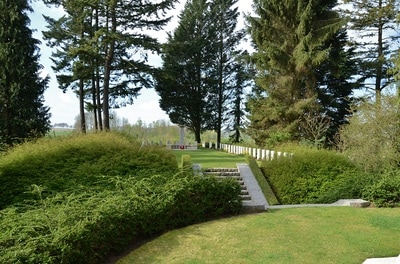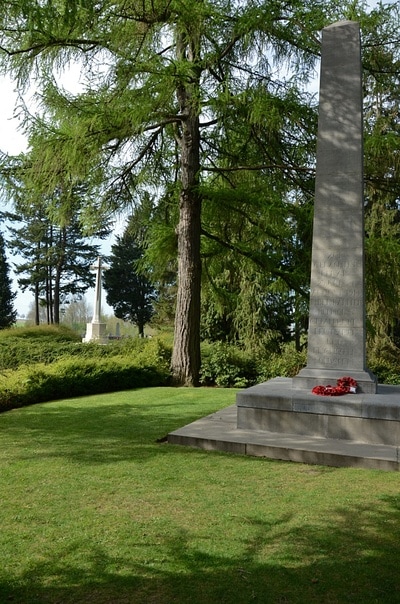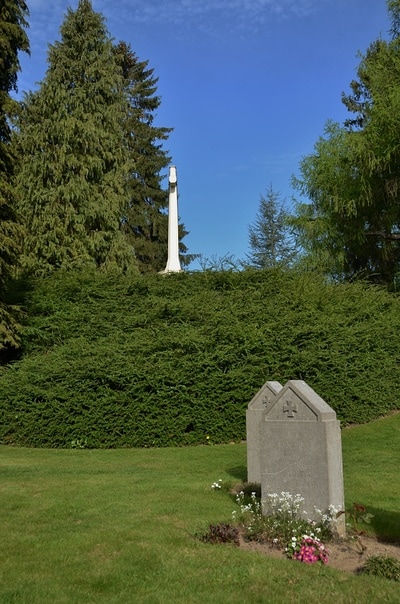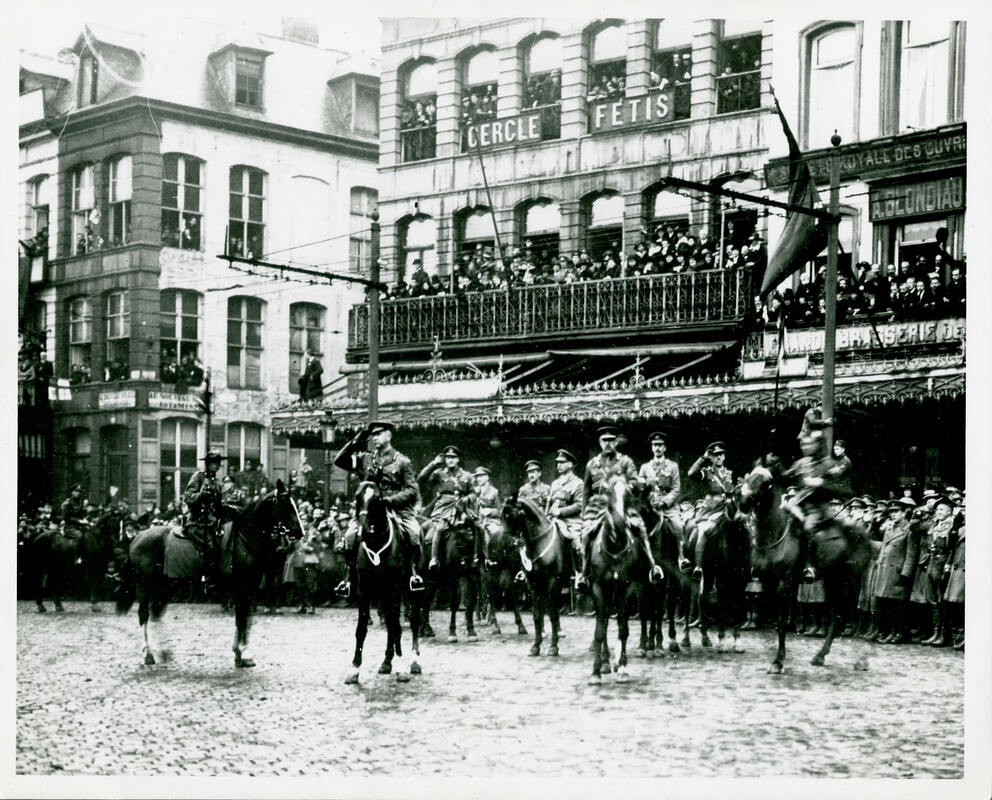ST. SYMPHORIEN MILITARY CEMETERY
Hainaut
Belgium
GPS Coordinates - Latitude: 50.43271, Longitude: 4.01102
Location Information
St. Symphorien Military Cemetery is located 2 Kms east of Mons on the N90 a road leading to Charleroi. On reaching St. Symphorien the right hand turning from the N90 leads onto the Rue Nestor Dehon. The cemetery lies 200 metres along the Rue Nestor Dehon.
Visiting Information
The location and design of this site makes wheelchair access impossible and can be difficult to access for visitors with limited mobility.
Historical Information
The cemetery at St. Symphorien was established by the German Army during the First World War as a final resting place for British and German soldiers killed at the Battle of Mons. Among those buried here is Private John Parr of the Middlesex Regiment, who was fatally wounded during an encounter with a German patrol two days before the battle, thus becoming the first British soldier to be killed in action on the Western Front. The cemetery remained in German hands until the end of the war, and afterwards came under the care of the Imperial (now Commonwealth) War Graves Commission. It also contains the graves of Commonwealth and German soldiers who died in the final days of the conflict, including George Ellison of the Royal Irish Lancers and George Price of the Canadian Infantry. Ellison and Price were killed on 11 November 1918, and are believed to be the last Commonwealth combat casualties of the war in Europe. There are 229 Commonwealth and 284 German servicemen buried or commemorated at St Symphorien, of whom 105 remain unidentified.
The Battle of Mons
By the evening of 22 August 1914, the men of II Corps of the British Expeditionary Force had taken up defensive positions along the Mons-Condé Canal, preparing for a major German attack expected to come from the north the next day. The opening shots of the Battle of Mons were fired at dawn on the morning of Sunday 23 August, when the 4th Battalion of the Middlesex Regiment repulsed German cavalry who were attempting to the cross the canal over a bridge at Obourg. The early morning was misty and wet, and the British were still uncertain of the numbers of enemy troops on the far side of the canal. By 10 a.m., the day had brightened up, artillery fire had intensified, and it became clear that they were facing a large German force.
Despite being outnumbered, the British soldiers on the south bank of the canal fought tenaciously throughout the day. Many were reservists who had returned to the army just weeks before, but they were well-drilled and disciplined, with a high-level of rifle training. Their relentless fire inflicted heavy casualties among the Germans. Despite this stiff resistance, the sheer weight of German numbers and the accuracy of their artillery meant that the British struggled to hold their positions. By 10.30 a.m. the first German soldiers had crossed the canal and some British units had been forced back, and by mid-afternoon German infantry troops were crossing in force. By nightfall, the Battle of Mons was over and the British had begun a long, hard retreat towards Paris.
Total Burials: 513.
Identified Casualties: Germany 244, United Kingdom 162, Canada 2. Total 408.
Unidentified Casualties: Total 105.
St. Symphorien Military Cemetery is located 2 Kms east of Mons on the N90 a road leading to Charleroi. On reaching St. Symphorien the right hand turning from the N90 leads onto the Rue Nestor Dehon. The cemetery lies 200 metres along the Rue Nestor Dehon.
Visiting Information
The location and design of this site makes wheelchair access impossible and can be difficult to access for visitors with limited mobility.
Historical Information
The cemetery at St. Symphorien was established by the German Army during the First World War as a final resting place for British and German soldiers killed at the Battle of Mons. Among those buried here is Private John Parr of the Middlesex Regiment, who was fatally wounded during an encounter with a German patrol two days before the battle, thus becoming the first British soldier to be killed in action on the Western Front. The cemetery remained in German hands until the end of the war, and afterwards came under the care of the Imperial (now Commonwealth) War Graves Commission. It also contains the graves of Commonwealth and German soldiers who died in the final days of the conflict, including George Ellison of the Royal Irish Lancers and George Price of the Canadian Infantry. Ellison and Price were killed on 11 November 1918, and are believed to be the last Commonwealth combat casualties of the war in Europe. There are 229 Commonwealth and 284 German servicemen buried or commemorated at St Symphorien, of whom 105 remain unidentified.
The Battle of Mons
By the evening of 22 August 1914, the men of II Corps of the British Expeditionary Force had taken up defensive positions along the Mons-Condé Canal, preparing for a major German attack expected to come from the north the next day. The opening shots of the Battle of Mons were fired at dawn on the morning of Sunday 23 August, when the 4th Battalion of the Middlesex Regiment repulsed German cavalry who were attempting to the cross the canal over a bridge at Obourg. The early morning was misty and wet, and the British were still uncertain of the numbers of enemy troops on the far side of the canal. By 10 a.m., the day had brightened up, artillery fire had intensified, and it became clear that they were facing a large German force.
Despite being outnumbered, the British soldiers on the south bank of the canal fought tenaciously throughout the day. Many were reservists who had returned to the army just weeks before, but they were well-drilled and disciplined, with a high-level of rifle training. Their relentless fire inflicted heavy casualties among the Germans. Despite this stiff resistance, the sheer weight of German numbers and the accuracy of their artillery meant that the British struggled to hold their positions. By 10.30 a.m. the first German soldiers had crossed the canal and some British units had been forced back, and by mid-afternoon German infantry troops were crossing in force. By nightfall, the Battle of Mons was over and the British had begun a long, hard retreat towards Paris.
Total Burials: 513.
Identified Casualties: Germany 244, United Kingdom 162, Canada 2. Total 408.
Unidentified Casualties: Total 105.
Lieutenant Maurice James Dease, V. C.
4th Bn. Royal Fusiliers
killed in action on 23rd August 1914 aged 24.
Plot 5 . B. 2.
Son of Edmund F. and Katherine M. Dease, of Levington, Mullingar, Co. Westmeath. One of the first British officer battle casualties of the war and the first posthumous recipient of the VC of the war.
His headstone bears the inscription "Requiescat In Pace"
Dease was born on 28 September 1889 in Gaulstown, Coole, County Westmeath, Ireland to Edmund Fitzlaurence Dease and Katherine Dease (née Murray). He was educated at Stonyhurst College and the Army Department of Wimbledon College before attending the Royal Military College, Sandhurst. He was 24 years old, and a lieutenant in the 4th Battalion, The Royal Fusiliers, and was awarded the VC for his actions on 23 August 1914, at Mons, Belgium.
Citation
An extract from "The London Gazette," dated 16th Nov., 1914. records the following:- "Though two or three times badly wounded he continued to control the fire of his machine guns at Mons on 23rd Aug., until all his men were shot. He died of his wounds."
Headstone
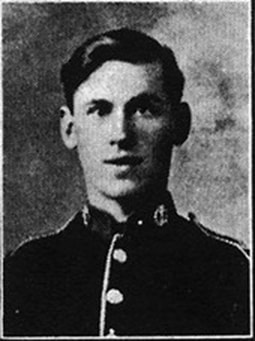
L/12880 Corporal
F. E. Agger
4th Bn. Middlesex Regiment
23rd August 1914.
Plot IV. B. 1
F. E. Agger
4th Bn. Middlesex Regiment
23rd August 1914.
Plot IV. B. 1

L/12643 Private
George Edwin Ellison
5th (Royal Irish) Lancers
11th November 1918, aged 40.
Plot I. B. 23.
Son of James W. and Mary Ellison; husband of Hannah Maria Ellison, of 49, Edmund Street, Bank, Leeds. Believed to be the last British battle casualty of the war.
George Edwin Ellison (1878 – 11 November 1918) was believed to be the last British soldier to be killed in action during the First World War. He died at 0930 hours (90 minutes before the armistice came into effect) whilst on a patrol on the outskirts of Mons, Belgium.
Ellison came from Leeds, England. Early in his life, he joined the army as a regular soldier, but had left by 1912 when he got married to Hannah Maria Burgan and had become a coal miner. Sometime just before the outbreak of war he was recalled to the army, joining the 5th Royal Irish Lancers, serving in the army at the start of the war. He fought at the Battle of Mons in 1914, and several other battles including the Battle of Ypres, Battle of Armentières, Battle of La Bassée, Battle of Lens, Battle of Loos, and Battle of Cambrai on the Western Front.
Ellison, stated to be aged 40, is buried in the St Symphorien Military Cemetery, just southeast of Mons. Coincidentally, and in large part due to Mons being lost in the very opening stages of the war and regained at the very end (from the British perspective), his grave faces that of John Parr, the first British soldier killed during the Great War.
He was survived by Hannah and a son, James Cornelius, just 5 days short of his fifth birthday when his father was killed.
George Edwin Ellison
5th (Royal Irish) Lancers
11th November 1918, aged 40.
Plot I. B. 23.
Son of James W. and Mary Ellison; husband of Hannah Maria Ellison, of 49, Edmund Street, Bank, Leeds. Believed to be the last British battle casualty of the war.
George Edwin Ellison (1878 – 11 November 1918) was believed to be the last British soldier to be killed in action during the First World War. He died at 0930 hours (90 minutes before the armistice came into effect) whilst on a patrol on the outskirts of Mons, Belgium.
Ellison came from Leeds, England. Early in his life, he joined the army as a regular soldier, but had left by 1912 when he got married to Hannah Maria Burgan and had become a coal miner. Sometime just before the outbreak of war he was recalled to the army, joining the 5th Royal Irish Lancers, serving in the army at the start of the war. He fought at the Battle of Mons in 1914, and several other battles including the Battle of Ypres, Battle of Armentières, Battle of La Bassée, Battle of Lens, Battle of Loos, and Battle of Cambrai on the Western Front.
Ellison, stated to be aged 40, is buried in the St Symphorien Military Cemetery, just southeast of Mons. Coincidentally, and in large part due to Mons being lost in the very opening stages of the war and regained at the very end (from the British perspective), his grave faces that of John Parr, the first British soldier killed during the Great War.
He was survived by Hannah and a son, James Cornelius, just 5 days short of his fifth birthday when his father was killed.
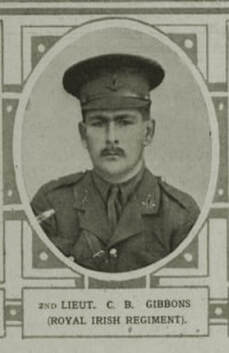
Second Lieutenant
Charles Barry Gibbons
2nd Bn. Royal Irish Regiment
24th August 1914.
Plot II. A. 6.
Inscription "God Keeps His Place In Eternal Life"
Royal Irish Regiment
Son of Lt. Col. James Barry Gibbons and Aimee Annie Gibbons, of 197, Maida Vale, London.
Charles Barry Gibbons
2nd Bn. Royal Irish Regiment
24th August 1914.
Plot II. A. 6.
Inscription "God Keeps His Place In Eternal Life"
Royal Irish Regiment
Son of Lt. Col. James Barry Gibbons and Aimee Annie Gibbons, of 197, Maida Vale, London.
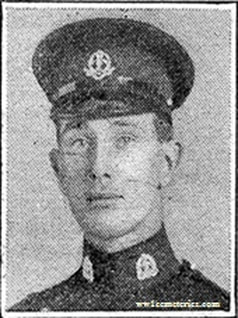
Lieutenant
Kenneth Parnell Henstock
4th Bn. Middlesex Regiment
23rd August 1914, aged 21.
Plot V. B. 5.
Son of Isabella Henstock, of 5, Bodorgan Rd., Bournemouth, and the late Col. F. T. Henstock.
Kenneth Parnell Henstock
4th Bn. Middlesex Regiment
23rd August 1914, aged 21.
Plot V. B. 5.
Son of Isabella Henstock, of 5, Bodorgan Rd., Bournemouth, and the late Col. F. T. Henstock.
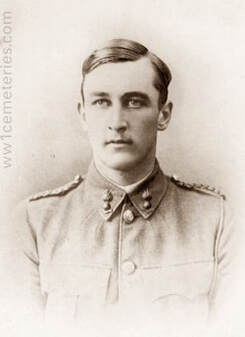
Second Lieutenant
Henry Wilfred Holt
56th Company, Royal Engineers
23rd August 1914.
Plot V. A. 4.
Inscription "Greater Love Hath No Man Than This"
Henry Wilfred Holt
56th Company, Royal Engineers
23rd August 1914.
Plot V. A. 4.
Inscription "Greater Love Hath No Man Than This"
Grand Place, Mons - 22nd August, 1914

22nd August 1914; Troops of "A" Company, 4th Battalion, Royal Fusiliers (7th Brigade, 3rd Division) resting in the Grand Place, Mons. On the following day the Battalion won two Victoria Crosses (Lieutenant Maurice Dease and Private Sidney Godley) on the canal bridge at Nimy, two miles north of Mons. © IWM Q 70071
Images in this gallery © Werner Van Caneghem
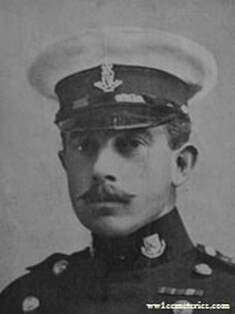
Captain
Walton Mellor
2nd Bn. Royal Irish Regiment
23rd August 1914, aged 36.
Plot II. A. 3
Son of Col. John Edwin Mellor, C.B., of Tan-y-Bryn, Abergele, Denbighshire; husband of Kathleen Geraldine Helen Mellor, of "Avonwood", Avonmore Avenue, Guildford.
Walton Mellor
2nd Bn. Royal Irish Regiment
23rd August 1914, aged 36.
Plot II. A. 3
Son of Col. John Edwin Mellor, C.B., of Tan-y-Bryn, Abergele, Denbighshire; husband of Kathleen Geraldine Helen Mellor, of "Avonwood", Avonmore Avenue, Guildford.

L14196 Private
John Henry Parr
4th Bn. Middlesex Regiment
21st August 1914, aged 17.
Plot I. A. 10.
Son of Edward Thomas and Alice Rosina Parr, of 52, Lodge Lane, North Finchley, Middlesex. Believed to be the first British battle casualty of the war.
Private John Henry Parr (19 July 1897 – 21 August 1914) was a British soldier.
Parr was born in Lichfield Grove, Finchley, now in the London Borough of Barnet. His father was a milkman. He lived most of his life at 52 Lodge Lane, North Finchley, the youngest of the eleven children of Edward and Alice Parr. Many of his siblings died before their fourth birthday.
On leaving school, he took a job as a butcher's boy, and then as golf caddy at North Middlesex Golf Club. Then, like many other young men of the time, he was attracted to the army as a potentially better way of life, and one where he would at least get two meals a day and a chance to see the world. The 5'3" tall Parr joined the 4th Battalion of the Middlesex Regiment in 1912, aged 15, but claimed to be 18 years and one month old to meet the minimum age requirement. He was nicknamed "Ole Parr", possibly after Old Tom Parr.
Private Parr specialised in becoming a reconnaissance cyclist, riding ahead to uncover information then returning with all possible speed to update the commanding officer. At the start of World War I in August 1914 Parr’s battalion was shipped from Southampton to Boulogne-sur-Mer, France. With the German army marching into Belgium, Parr's unit took up positions near a village called Bettignies, beside the canal running through the town of Mons approximately 8 miles (13 km) away. On 21 August, Parr and another cyclist were sent to the village of Obourg, just north east of Mons, and slightly over the border in Belgium, with a mission to locate the enemy. It is believed that they encountered a cavalry patrol from the German First Army, and that Parr remained to hold off the enemy whilst his companion returned to report. He was killed in the ensuing rifle fire.
Since the British army retreated to a new position around the Marne after the first battle of Mons, Parr's body was left behind. In the ensuing months, the slow entrenchment of the war meant that news of Parr's death was not recognised until much later. After a while his mother wrote to the regiment asking about her son, but they were unable to tell her of his condition, and it may have been that they thought that he had been captured. At the time, there were no dog tags to help with the identification of casualties. The circumstances of his death remain unclear: the front line was approximately 11 miles (18 km) away, and he may have been killed by friendly fire rather than a German patrol, or in the Battle of Mons on 23 August.
Parr is buried in the St Symphorien Military Cemetery, just southeast of Mons, and his age is given on the gravestone as twenty, the army not knowing his true age of seventeen. Coincidentally, his grave faces that of George Edwin Ellison, the last British soldier killed during the Great War.
On 21 August 2014, the 100th anniversary of Parr's death, a memorial paving stone was ceremonially unveiled in the pavement outside 52 Lodge Lane. The ceremony was attended by about 300 people, including local dignitaries and Parr family members, one of whom read a letter from his mother to the War Office written in October 1914 to enquire about him. A memorial "standing stone" nearby, to bear a plaque with further details of Parr's life and death, is planned. A plaque has also been placed in the golf club where he worked as a caddy.
While Parr is believed to be the first Commonwealth soldier killed in action, several soldiers had been killed by friendly fire and accidental shooting after the declaration of war but before troops were sent overseas, starting with Cpl Arthur Rawson on 9 August 1914. Even earlier, on 6 August 1914, the cruiser HMS Amphion (1911) hit a German mine and sank, killing about 150 sailors.
John Henry Parr
4th Bn. Middlesex Regiment
21st August 1914, aged 17.
Plot I. A. 10.
Son of Edward Thomas and Alice Rosina Parr, of 52, Lodge Lane, North Finchley, Middlesex. Believed to be the first British battle casualty of the war.
Private John Henry Parr (19 July 1897 – 21 August 1914) was a British soldier.
Parr was born in Lichfield Grove, Finchley, now in the London Borough of Barnet. His father was a milkman. He lived most of his life at 52 Lodge Lane, North Finchley, the youngest of the eleven children of Edward and Alice Parr. Many of his siblings died before their fourth birthday.
On leaving school, he took a job as a butcher's boy, and then as golf caddy at North Middlesex Golf Club. Then, like many other young men of the time, he was attracted to the army as a potentially better way of life, and one where he would at least get two meals a day and a chance to see the world. The 5'3" tall Parr joined the 4th Battalion of the Middlesex Regiment in 1912, aged 15, but claimed to be 18 years and one month old to meet the minimum age requirement. He was nicknamed "Ole Parr", possibly after Old Tom Parr.
Private Parr specialised in becoming a reconnaissance cyclist, riding ahead to uncover information then returning with all possible speed to update the commanding officer. At the start of World War I in August 1914 Parr’s battalion was shipped from Southampton to Boulogne-sur-Mer, France. With the German army marching into Belgium, Parr's unit took up positions near a village called Bettignies, beside the canal running through the town of Mons approximately 8 miles (13 km) away. On 21 August, Parr and another cyclist were sent to the village of Obourg, just north east of Mons, and slightly over the border in Belgium, with a mission to locate the enemy. It is believed that they encountered a cavalry patrol from the German First Army, and that Parr remained to hold off the enemy whilst his companion returned to report. He was killed in the ensuing rifle fire.
Since the British army retreated to a new position around the Marne after the first battle of Mons, Parr's body was left behind. In the ensuing months, the slow entrenchment of the war meant that news of Parr's death was not recognised until much later. After a while his mother wrote to the regiment asking about her son, but they were unable to tell her of his condition, and it may have been that they thought that he had been captured. At the time, there were no dog tags to help with the identification of casualties. The circumstances of his death remain unclear: the front line was approximately 11 miles (18 km) away, and he may have been killed by friendly fire rather than a German patrol, or in the Battle of Mons on 23 August.
Parr is buried in the St Symphorien Military Cemetery, just southeast of Mons, and his age is given on the gravestone as twenty, the army not knowing his true age of seventeen. Coincidentally, his grave faces that of George Edwin Ellison, the last British soldier killed during the Great War.
On 21 August 2014, the 100th anniversary of Parr's death, a memorial paving stone was ceremonially unveiled in the pavement outside 52 Lodge Lane. The ceremony was attended by about 300 people, including local dignitaries and Parr family members, one of whom read a letter from his mother to the War Office written in October 1914 to enquire about him. A memorial "standing stone" nearby, to bear a plaque with further details of Parr's life and death, is planned. A plaque has also been placed in the golf club where he worked as a caddy.
While Parr is believed to be the first Commonwealth soldier killed in action, several soldiers had been killed by friendly fire and accidental shooting after the declaration of war but before troops were sent overseas, starting with Cpl Arthur Rawson on 9 August 1914. Even earlier, on 6 August 1914, the cruiser HMS Amphion (1911) hit a German mine and sank, killing about 150 sailors.
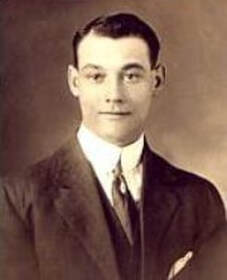
256265 Private
George Lawrence Price
28th Bn. Canadian Infantry
11th November 1918, aged 25.
Plot V. C. 4.
Son of James E. and Annie R. Price of Port Williams, Kings Co., Nova Scotia. Believed to be the last Canadian battle casualty of the war. (originally buried in Havre Old Communal Cemetery).
George Lawrence Price
28th Bn. Canadian Infantry
11th November 1918, aged 25.
Plot V. C. 4.
Son of James E. and Annie R. Price of Port Williams, Kings Co., Nova Scotia. Believed to be the last Canadian battle casualty of the war. (originally buried in Havre Old Communal Cemetery).
Private George Lawrence Price (Regimental Number: 256265) (December 15, 1892 – November 11, 1918) was a Canadian soldier. He is traditionally recognized as the last soldier of the British Empire to be killed during the First World War.
The 28th Battalion had orders for November 11 to advance from Frameries (South of Mons) and continue to the village of Havre, securing all the bridges on the Canal du Centre. The battalion advanced rapidly staring at 4:00 a.m., pushing back light German resistance and they reached their position along the canal facing Ville-sur-Haine by 9:00 a.m. where the battalion received a message that all hostilities would cease at 11:00 a.m. Price and fellow soldier Art Goodworthy were worried that the battalion's position on the open canal bank was exposed to German positions on the opposite side of the canal where they could see bricks had been knocked out from house dormers to create firing positions. According to Goodworthy, they decided on their own initiative to take a patrol of five men across the bridge to search the houses. Reaching the houses and checking them one by one, they discovered German soldiers mounting machine guns along a brick wall overlooking the canal. The Germans opened fire on the patrol with heavy machine gun fire but the Canadians were protected by the brick walls of one of the houses. Aware that they had been discovered and outflanked, the Germans began to retreat. A Belgian family in one of the houses warned the Canadians to be careful as they followed the retreating Germans. George Price was fatally shot in the chest by a German sniper as he stepped out of the house into the street. He was pulled into one of the houses and treated by a young Belgian nurse who ran across the street to help, but died a minute later at 10:58 a.m., November 11, 1918. His death was just two minutes before the armistice ceasefire, that ended the war, came into effect at 11 a.m.
The 28th Battalion had orders for November 11 to advance from Frameries (South of Mons) and continue to the village of Havre, securing all the bridges on the Canal du Centre. The battalion advanced rapidly staring at 4:00 a.m., pushing back light German resistance and they reached their position along the canal facing Ville-sur-Haine by 9:00 a.m. where the battalion received a message that all hostilities would cease at 11:00 a.m. Price and fellow soldier Art Goodworthy were worried that the battalion's position on the open canal bank was exposed to German positions on the opposite side of the canal where they could see bricks had been knocked out from house dormers to create firing positions. According to Goodworthy, they decided on their own initiative to take a patrol of five men across the bridge to search the houses. Reaching the houses and checking them one by one, they discovered German soldiers mounting machine guns along a brick wall overlooking the canal. The Germans opened fire on the patrol with heavy machine gun fire but the Canadians were protected by the brick walls of one of the houses. Aware that they had been discovered and outflanked, the Germans began to retreat. A Belgian family in one of the houses warned the Canadians to be careful as they followed the retreating Germans. George Price was fatally shot in the chest by a German sniper as he stepped out of the house into the street. He was pulled into one of the houses and treated by a young Belgian nurse who ran across the street to help, but died a minute later at 10:58 a.m., November 11, 1918. His death was just two minutes before the armistice ceasefire, that ended the war, came into effect at 11 a.m.

Lieutenant
Leslie Richmond
1st Bn. Gordon Highlanders
23rd August 1914, aged 26.
Plot I. B. 34.
Son of James Richmond, of Kippenross, Dunblane; husband of Ruth Margaret Richmond.
Leslie Richmond
1st Bn. Gordon Highlanders
23rd August 1914, aged 26.
Plot I. B. 34.
Son of James Richmond, of Kippenross, Dunblane; husband of Ruth Margaret Richmond.
Images in this gallery © Geerhard Joos
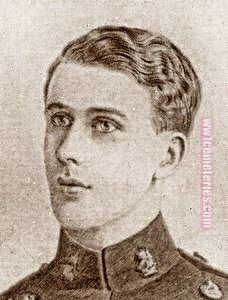
Lieutenant
Dougal Clifford Campbell Sewell
3rd Bn. attd. 1st Bn. Queen's Own (Royal West Kent Regiment)
10th September 1914, aged 20.
Plot I. B. 30.
Son of Mrs. William Sewell, of Annandale, West Byfleet, and the late William Sewell.
Dougal Clifford Campbell Sewell
3rd Bn. attd. 1st Bn. Queen's Own (Royal West Kent Regiment)
10th September 1914, aged 20.
Plot I. B. 30.
Son of Mrs. William Sewell, of Annandale, West Byfleet, and the late William Sewell.
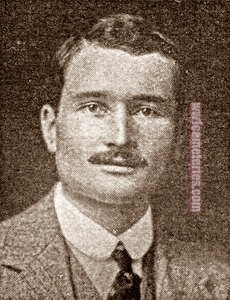
Lieutenant
Everard Cecil Smith
4th Bn. Royal Fusiliers
23rd August 1914, aged 29.
Plot II. A. 5.
Son of the Rev. Cecil Evan Smith and Rosamond Linda Smith. Born at Titsey, Surrey.
Everard Cecil Smith
4th Bn. Royal Fusiliers
23rd August 1914, aged 29.
Plot II. A. 5.
Son of the Rev. Cecil Evan Smith and Rosamond Linda Smith. Born at Titsey, Surrey.

Lieutenant
John Rothes Marlow Wilkinson
4th Bn. Middlesex Regiment
23rd August 1914, aged 26.
Plot II. A. 4.
Son of the Rev. H. M. Wilkinson and Mrs. F. A. Wilkinson. Born at Milford, Hants.
John Rothes Marlow Wilkinson
4th Bn. Middlesex Regiment
23rd August 1914, aged 26.
Plot II. A. 4.
Son of the Rev. H. M. Wilkinson and Mrs. F. A. Wilkinson. Born at Milford, Hants.
Images in this gallery © Johan Pauwels
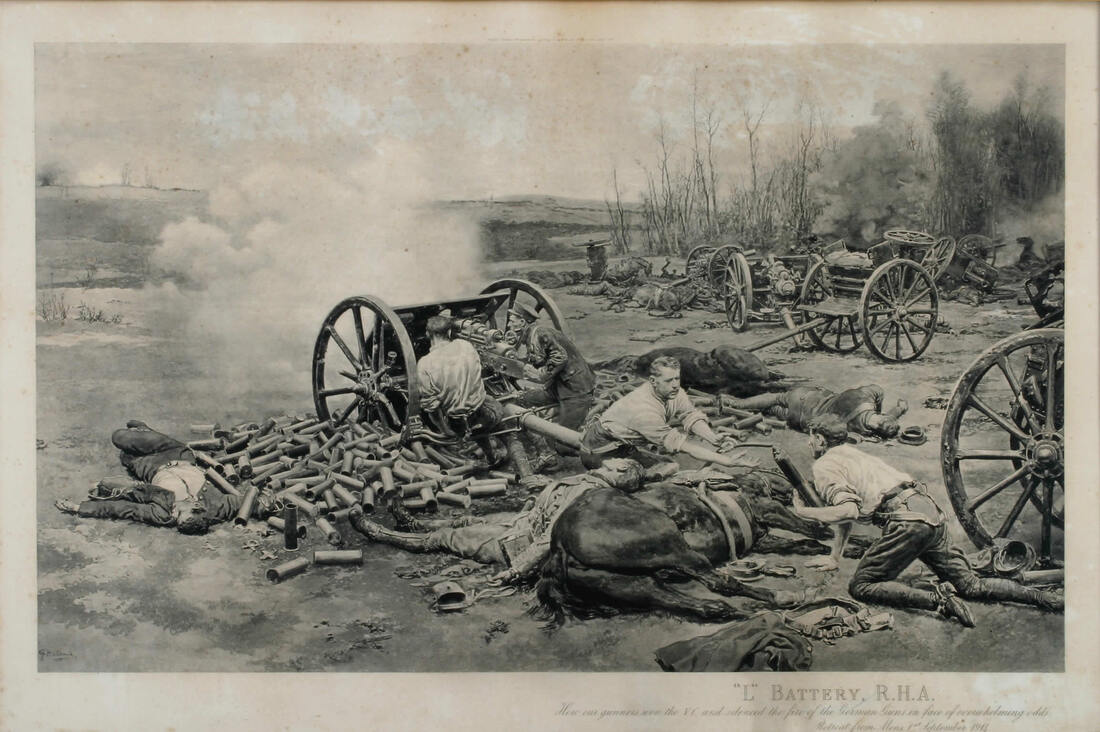
"L" Battery, R.H.A. Retreat from Mons. This British Horse artillery unit made a heroic stand against advancing German troops during the retreat from Mons, Belgium on 1 September 1914. Mons stayed in German hands until liberated by Canadian troops on the last day of the war, 11 November 1918. © Canadian War Museum
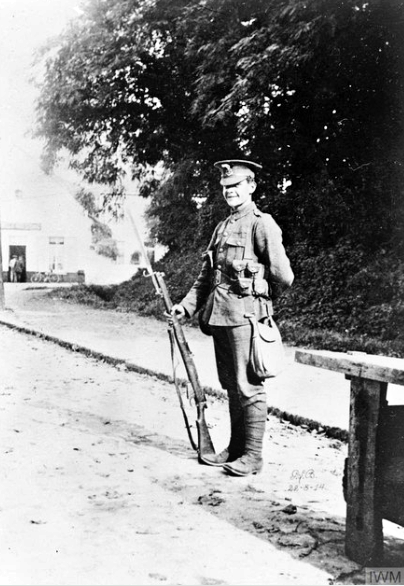
Private Arthur Frederick Carter of "D" Company, 4th Battalion, Middlesex Regiment (8th Brigade, 3rd Division) on sentry duty at Mons. Photograph taken on Saturday 5 pm, 22 August 1914. The coffee house and six other buildings nearby were burned by German shells during the action of the following day. Towards the right is the Chaussee de Beaumont. Arthur, who was believed to be aged 20 when this image was taken, survived the war. © IWM Q 70070



